Physiology: Study of Life and Adaptation to Extreme Temperatures
VerifiedAdded on 2023/01/03
|18
|6213
|75
AI Summary
This article provides an overview of physiology, the study of life and the functions of living organisms. It explores the history of physiology and its impact on our understanding of the human body. The article also discusses the main mechanisms of temperature regulation and the body's adaptation to extreme temperatures. It concludes with a discussion on the effects of extreme cold on the cardiovascular system.
Contribute Materials
Your contribution can guide someone’s learning journey. Share your
documents today.
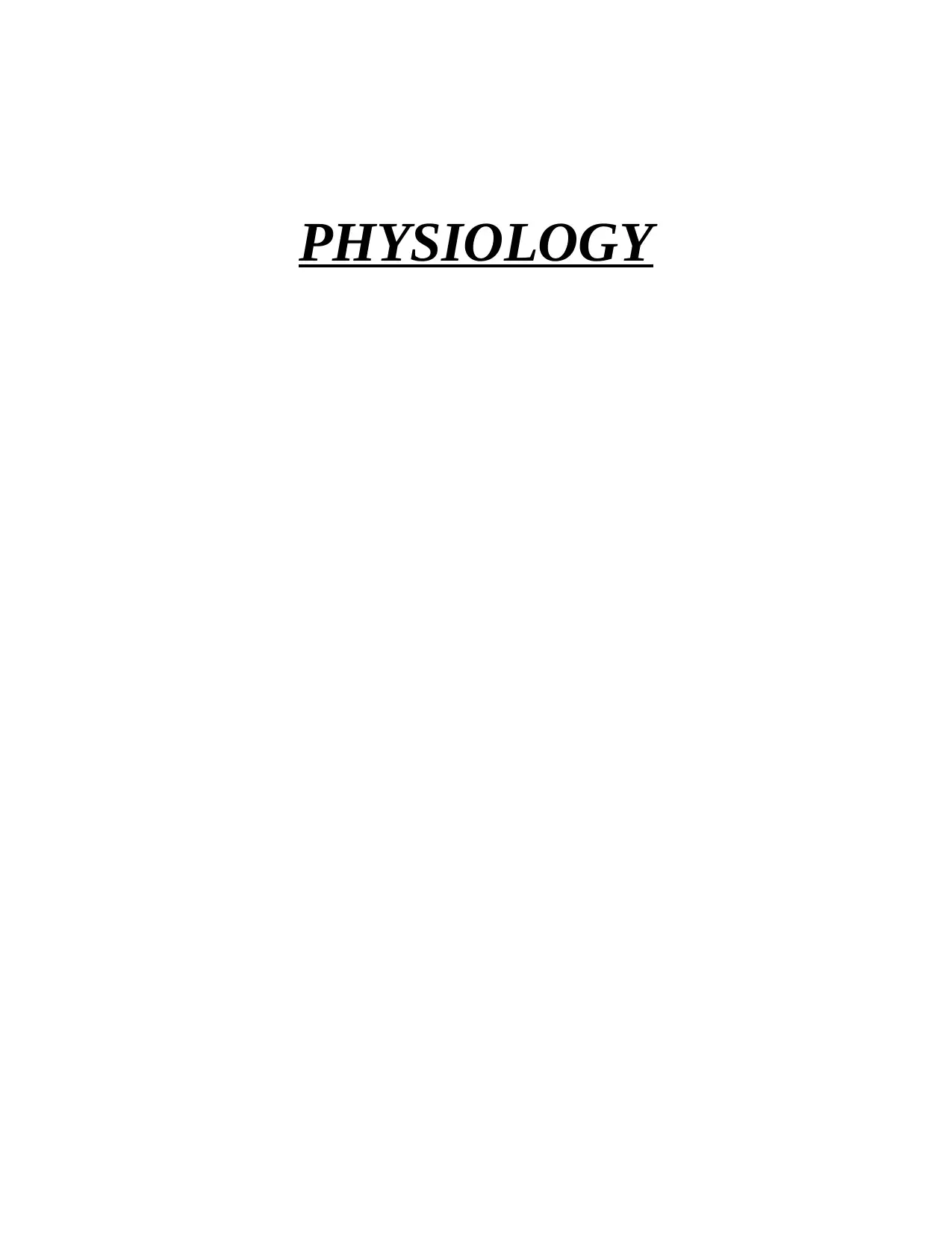
PHYSIOLOGY
Secure Best Marks with AI Grader
Need help grading? Try our AI Grader for instant feedback on your assignments.
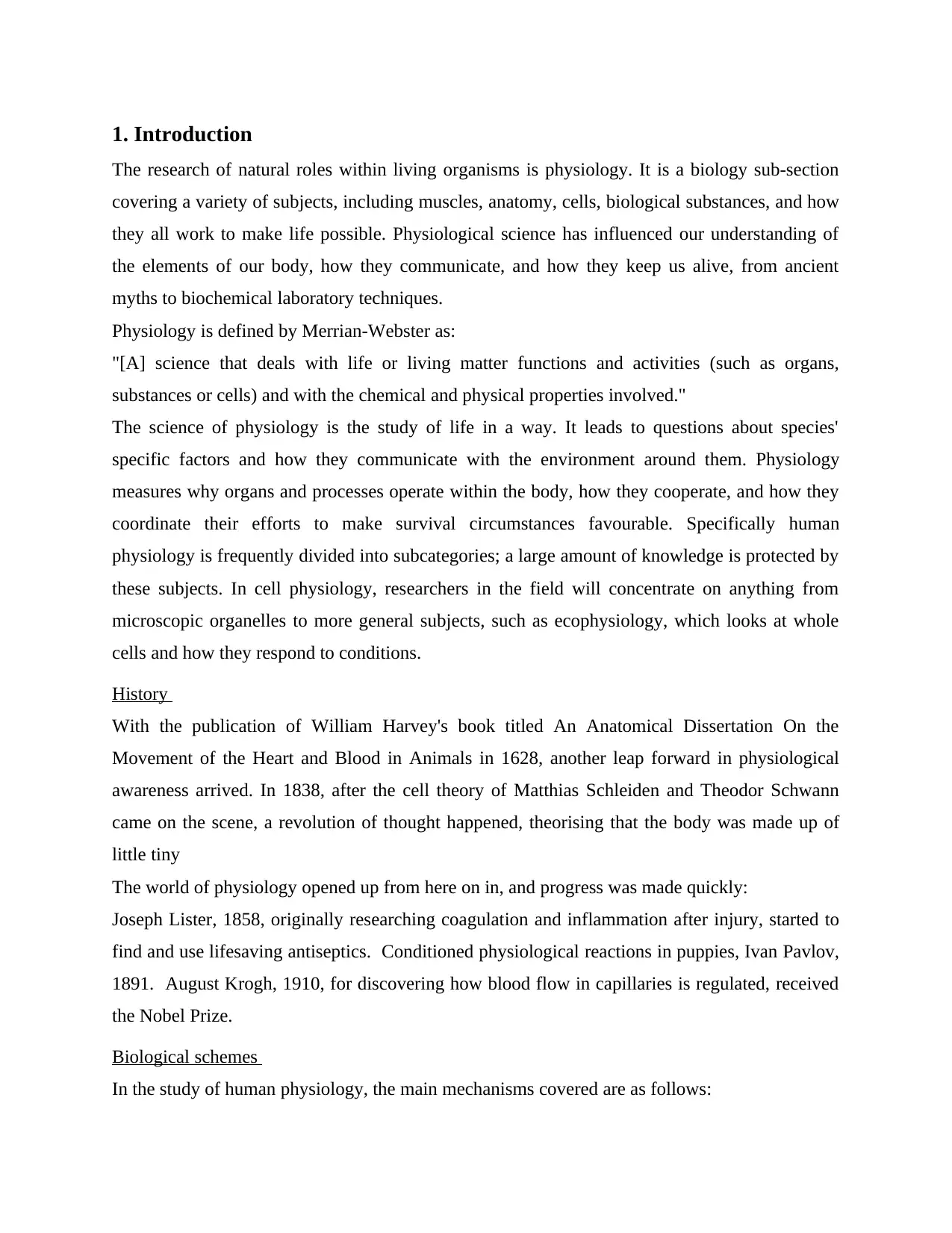
1. Introduction
The research of natural roles within living organisms is physiology. It is a biology sub-section
covering a variety of subjects, including muscles, anatomy, cells, biological substances, and how
they all work to make life possible. Physiological science has influenced our understanding of
the elements of our body, how they communicate, and how they keep us alive, from ancient
myths to biochemical laboratory techniques.
Physiology is defined by Merrian-Webster as:
"[A] science that deals with life or living matter functions and activities (such as organs,
substances or cells) and with the chemical and physical properties involved."
The science of physiology is the study of life in a way. It leads to questions about species'
specific factors and how they communicate with the environment around them. Physiology
measures why organs and processes operate within the body, how they cooperate, and how they
coordinate their efforts to make survival circumstances favourable. Specifically human
physiology is frequently divided into subcategories; a large amount of knowledge is protected by
these subjects. In cell physiology, researchers in the field will concentrate on anything from
microscopic organelles to more general subjects, such as ecophysiology, which looks at whole
cells and how they respond to conditions.
History
With the publication of William Harvey's book titled An Anatomical Dissertation On the
Movement of the Heart and Blood in Animals in 1628, another leap forward in physiological
awareness arrived. In 1838, after the cell theory of Matthias Schleiden and Theodor Schwann
came on the scene, a revolution of thought happened, theorising that the body was made up of
little tiny
The world of physiology opened up from here on in, and progress was made quickly:
Joseph Lister, 1858, originally researching coagulation and inflammation after injury, started to
find and use lifesaving antiseptics. Conditioned physiological reactions in puppies, Ivan Pavlov,
1891. August Krogh, 1910, for discovering how blood flow in capillaries is regulated, received
the Nobel Prize.
Biological schemes
In the study of human physiology, the main mechanisms covered are as follows:
The research of natural roles within living organisms is physiology. It is a biology sub-section
covering a variety of subjects, including muscles, anatomy, cells, biological substances, and how
they all work to make life possible. Physiological science has influenced our understanding of
the elements of our body, how they communicate, and how they keep us alive, from ancient
myths to biochemical laboratory techniques.
Physiology is defined by Merrian-Webster as:
"[A] science that deals with life or living matter functions and activities (such as organs,
substances or cells) and with the chemical and physical properties involved."
The science of physiology is the study of life in a way. It leads to questions about species'
specific factors and how they communicate with the environment around them. Physiology
measures why organs and processes operate within the body, how they cooperate, and how they
coordinate their efforts to make survival circumstances favourable. Specifically human
physiology is frequently divided into subcategories; a large amount of knowledge is protected by
these subjects. In cell physiology, researchers in the field will concentrate on anything from
microscopic organelles to more general subjects, such as ecophysiology, which looks at whole
cells and how they respond to conditions.
History
With the publication of William Harvey's book titled An Anatomical Dissertation On the
Movement of the Heart and Blood in Animals in 1628, another leap forward in physiological
awareness arrived. In 1838, after the cell theory of Matthias Schleiden and Theodor Schwann
came on the scene, a revolution of thought happened, theorising that the body was made up of
little tiny
The world of physiology opened up from here on in, and progress was made quickly:
Joseph Lister, 1858, originally researching coagulation and inflammation after injury, started to
find and use lifesaving antiseptics. Conditioned physiological reactions in puppies, Ivan Pavlov,
1891. August Krogh, 1910, for discovering how blood flow in capillaries is regulated, received
the Nobel Prize.
Biological schemes
In the study of human physiology, the main mechanisms covered are as follows:
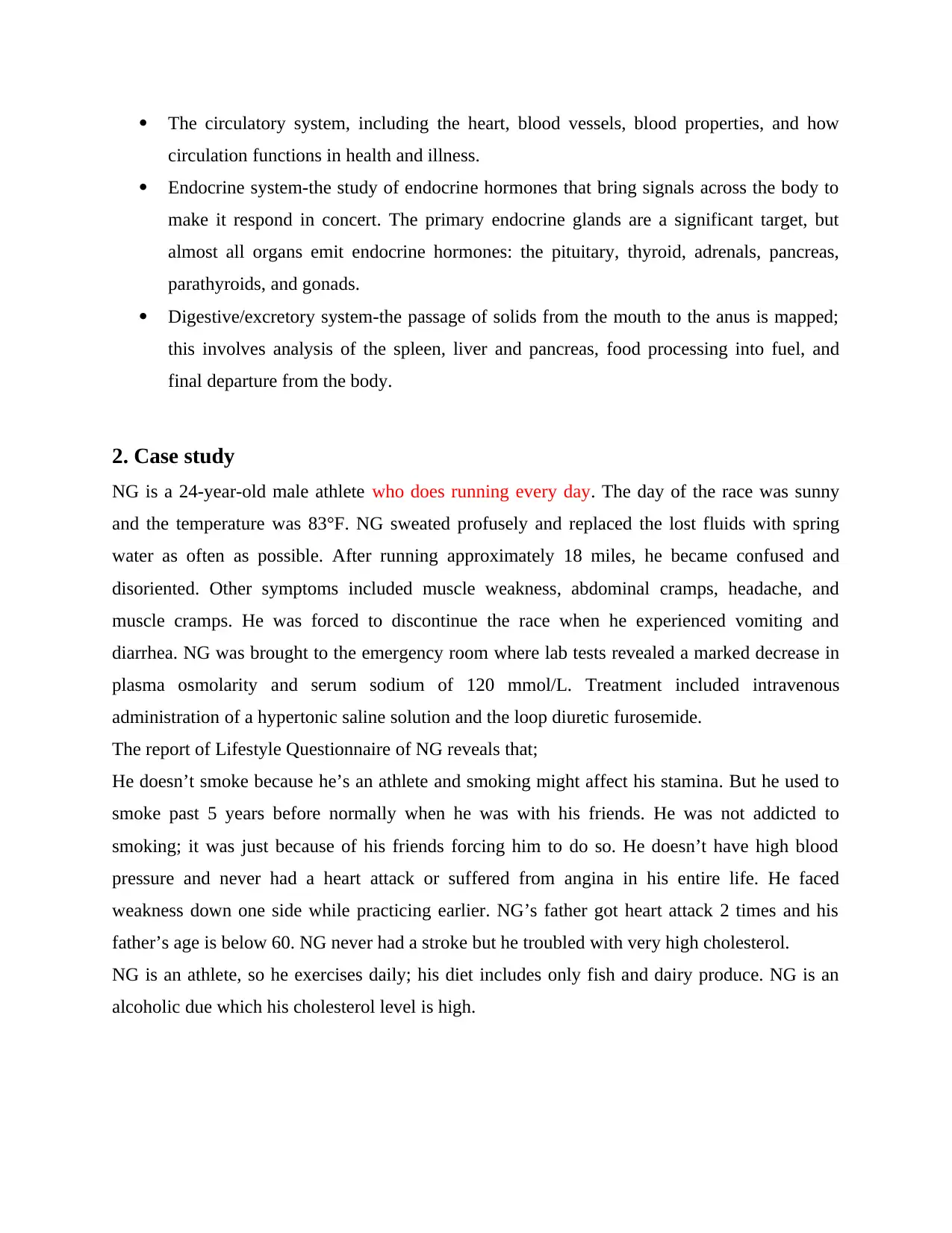
The circulatory system, including the heart, blood vessels, blood properties, and how
circulation functions in health and illness.
Endocrine system-the study of endocrine hormones that bring signals across the body to
make it respond in concert. The primary endocrine glands are a significant target, but
almost all organs emit endocrine hormones: the pituitary, thyroid, adrenals, pancreas,
parathyroids, and gonads.
Digestive/excretory system-the passage of solids from the mouth to the anus is mapped;
this involves analysis of the spleen, liver and pancreas, food processing into fuel, and
final departure from the body.
2. Case study
NG is a 24-year-old male athlete who does running every day. The day of the race was sunny
and the temperature was 83°F. NG sweated profusely and replaced the lost fluids with spring
water as often as possible. After running approximately 18 miles, he became confused and
disoriented. Other symptoms included muscle weakness, abdominal cramps, headache, and
muscle cramps. He was forced to discontinue the race when he experienced vomiting and
diarrhea. NG was brought to the emergency room where lab tests revealed a marked decrease in
plasma osmolarity and serum sodium of 120 mmol/L. Treatment included intravenous
administration of a hypertonic saline solution and the loop diuretic furosemide.
The report of Lifestyle Questionnaire of NG reveals that;
He doesn’t smoke because he’s an athlete and smoking might affect his stamina. But he used to
smoke past 5 years before normally when he was with his friends. He was not addicted to
smoking; it was just because of his friends forcing him to do so. He doesn’t have high blood
pressure and never had a heart attack or suffered from angina in his entire life. He faced
weakness down one side while practicing earlier. NG’s father got heart attack 2 times and his
father’s age is below 60. NG never had a stroke but he troubled with very high cholesterol.
NG is an athlete, so he exercises daily; his diet includes only fish and dairy produce. NG is an
alcoholic due which his cholesterol level is high.
circulation functions in health and illness.
Endocrine system-the study of endocrine hormones that bring signals across the body to
make it respond in concert. The primary endocrine glands are a significant target, but
almost all organs emit endocrine hormones: the pituitary, thyroid, adrenals, pancreas,
parathyroids, and gonads.
Digestive/excretory system-the passage of solids from the mouth to the anus is mapped;
this involves analysis of the spleen, liver and pancreas, food processing into fuel, and
final departure from the body.
2. Case study
NG is a 24-year-old male athlete who does running every day. The day of the race was sunny
and the temperature was 83°F. NG sweated profusely and replaced the lost fluids with spring
water as often as possible. After running approximately 18 miles, he became confused and
disoriented. Other symptoms included muscle weakness, abdominal cramps, headache, and
muscle cramps. He was forced to discontinue the race when he experienced vomiting and
diarrhea. NG was brought to the emergency room where lab tests revealed a marked decrease in
plasma osmolarity and serum sodium of 120 mmol/L. Treatment included intravenous
administration of a hypertonic saline solution and the loop diuretic furosemide.
The report of Lifestyle Questionnaire of NG reveals that;
He doesn’t smoke because he’s an athlete and smoking might affect his stamina. But he used to
smoke past 5 years before normally when he was with his friends. He was not addicted to
smoking; it was just because of his friends forcing him to do so. He doesn’t have high blood
pressure and never had a heart attack or suffered from angina in his entire life. He faced
weakness down one side while practicing earlier. NG’s father got heart attack 2 times and his
father’s age is below 60. NG never had a stroke but he troubled with very high cholesterol.
NG is an athlete, so he exercises daily; his diet includes only fish and dairy produce. NG is an
alcoholic due which his cholesterol level is high.
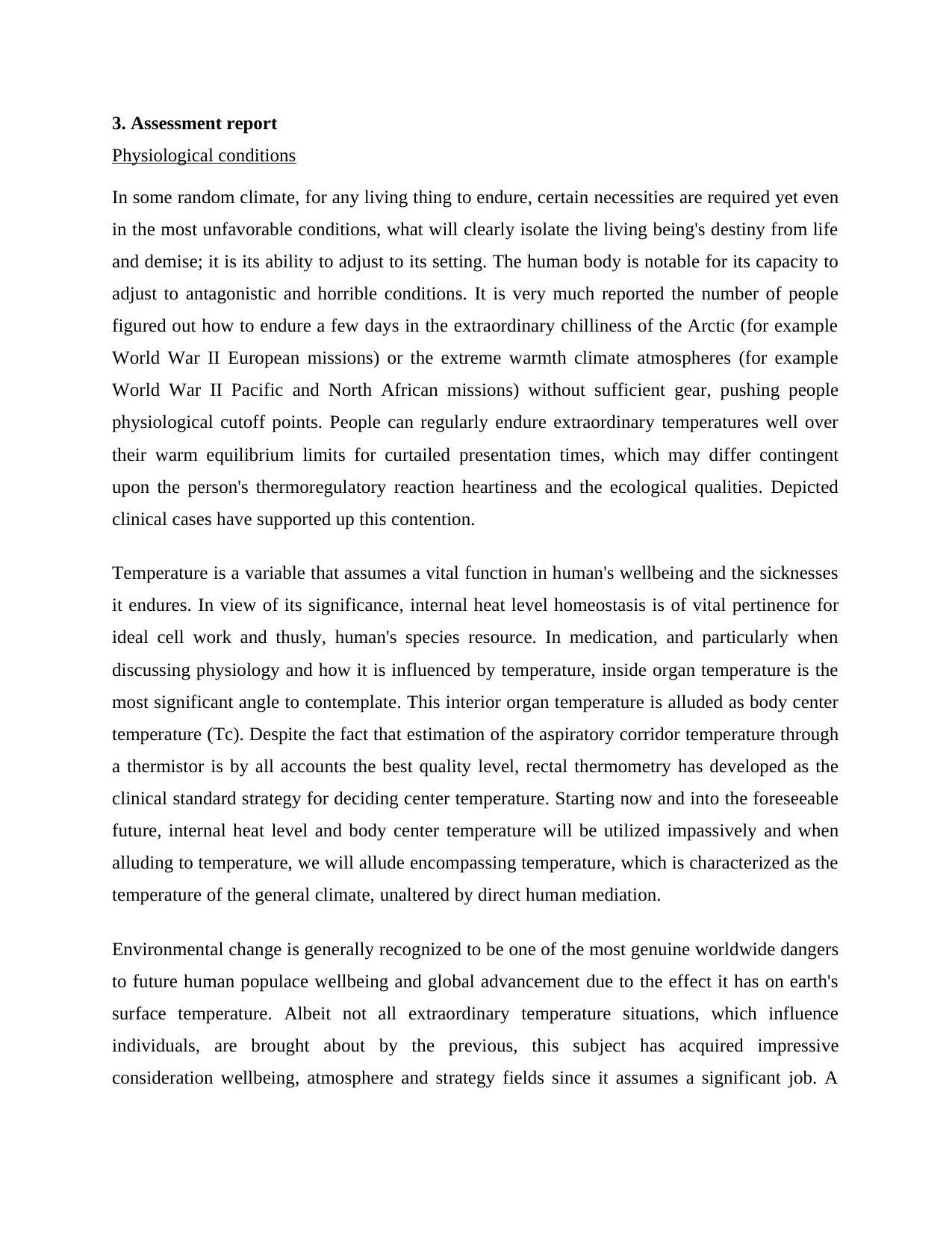
3. Assessment report
Physiological conditions
In some random climate, for any living thing to endure, certain necessities are required yet even
in the most unfavorable conditions, what will clearly isolate the living being's destiny from life
and demise; it is its ability to adjust to its setting. The human body is notable for its capacity to
adjust to antagonistic and horrible conditions. It is very much reported the number of people
figured out how to endure a few days in the extraordinary chilliness of the Arctic (for example
World War II European missions) or the extreme warmth climate atmospheres (for example
World War II Pacific and North African missions) without sufficient gear, pushing people
physiological cutoff points. People can regularly endure extraordinary temperatures well over
their warm equilibrium limits for curtailed presentation times, which may differ contingent
upon the person's thermoregulatory reaction heartiness and the ecological qualities. Depicted
clinical cases have supported up this contention.
Temperature is a variable that assumes a vital function in human's wellbeing and the sicknesses
it endures. In view of its significance, internal heat level homeostasis is of vital pertinence for
ideal cell work and thusly, human's species resource. In medication, and particularly when
discussing physiology and how it is influenced by temperature, inside organ temperature is the
most significant angle to contemplate. This interior organ temperature is alluded as body center
temperature (Tc). Despite the fact that estimation of the aspiratory corridor temperature through
a thermistor is by all accounts the best quality level, rectal thermometry has developed as the
clinical standard strategy for deciding center temperature. Starting now and into the foreseeable
future, internal heat level and body center temperature will be utilized impassively and when
alluding to temperature, we will allude encompassing temperature, which is characterized as the
temperature of the general climate, unaltered by direct human mediation.
Environmental change is generally recognized to be one of the most genuine worldwide dangers
to future human populace wellbeing and global advancement due to the effect it has on earth's
surface temperature. Albeit not all extraordinary temperature situations, which influence
individuals, are brought about by the previous, this subject has acquired impressive
consideration wellbeing, atmosphere and strategy fields since it assumes a significant job. A
Physiological conditions
In some random climate, for any living thing to endure, certain necessities are required yet even
in the most unfavorable conditions, what will clearly isolate the living being's destiny from life
and demise; it is its ability to adjust to its setting. The human body is notable for its capacity to
adjust to antagonistic and horrible conditions. It is very much reported the number of people
figured out how to endure a few days in the extraordinary chilliness of the Arctic (for example
World War II European missions) or the extreme warmth climate atmospheres (for example
World War II Pacific and North African missions) without sufficient gear, pushing people
physiological cutoff points. People can regularly endure extraordinary temperatures well over
their warm equilibrium limits for curtailed presentation times, which may differ contingent
upon the person's thermoregulatory reaction heartiness and the ecological qualities. Depicted
clinical cases have supported up this contention.
Temperature is a variable that assumes a vital function in human's wellbeing and the sicknesses
it endures. In view of its significance, internal heat level homeostasis is of vital pertinence for
ideal cell work and thusly, human's species resource. In medication, and particularly when
discussing physiology and how it is influenced by temperature, inside organ temperature is the
most significant angle to contemplate. This interior organ temperature is alluded as body center
temperature (Tc). Despite the fact that estimation of the aspiratory corridor temperature through
a thermistor is by all accounts the best quality level, rectal thermometry has developed as the
clinical standard strategy for deciding center temperature. Starting now and into the foreseeable
future, internal heat level and body center temperature will be utilized impassively and when
alluding to temperature, we will allude encompassing temperature, which is characterized as the
temperature of the general climate, unaltered by direct human mediation.
Environmental change is generally recognized to be one of the most genuine worldwide dangers
to future human populace wellbeing and global advancement due to the effect it has on earth's
surface temperature. Albeit not all extraordinary temperature situations, which influence
individuals, are brought about by the previous, this subject has acquired impressive
consideration wellbeing, atmosphere and strategy fields since it assumes a significant job. A
Secure Best Marks with AI Grader
Need help grading? Try our AI Grader for instant feedback on your assignments.
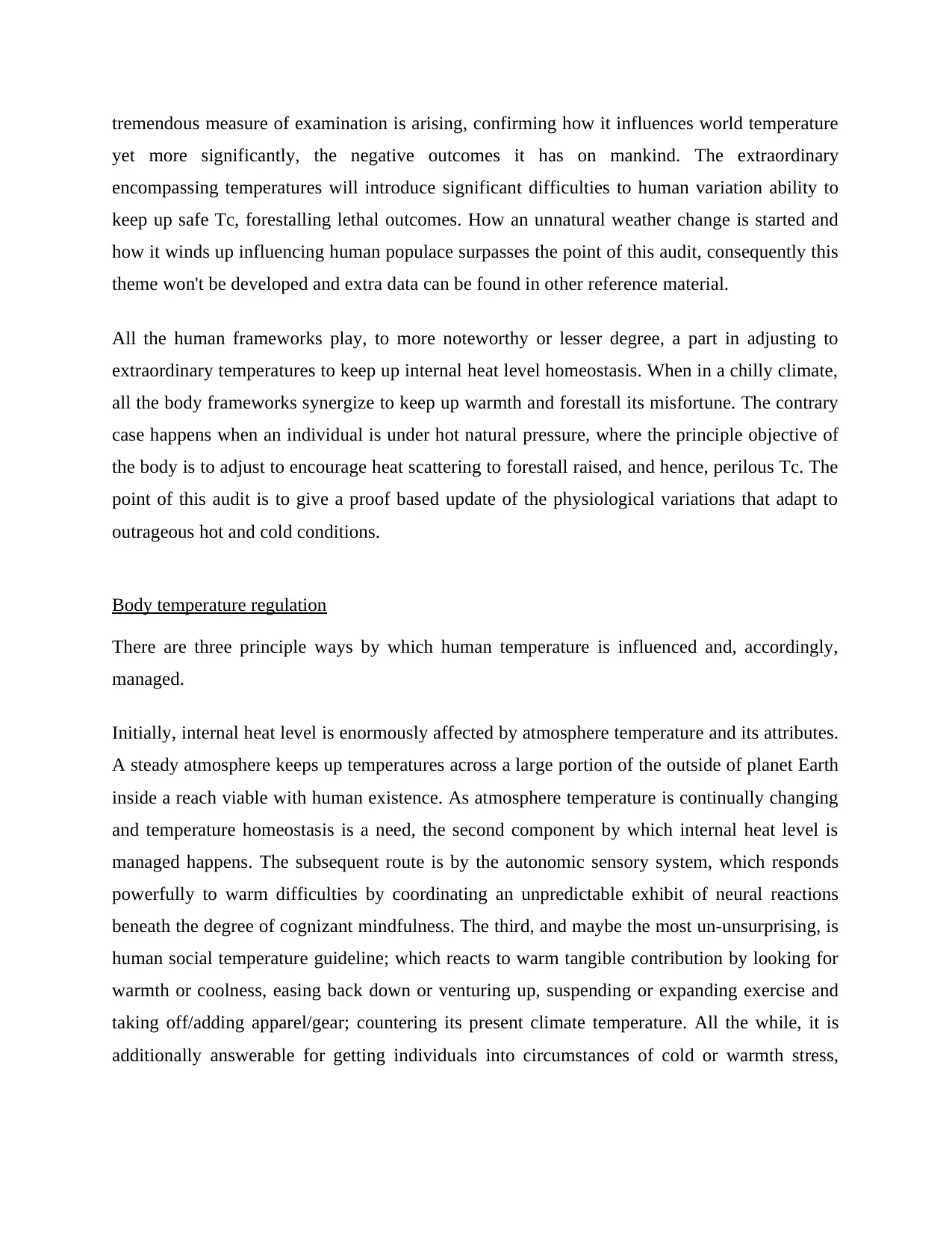
tremendous measure of examination is arising, confirming how it influences world temperature
yet more significantly, the negative outcomes it has on mankind. The extraordinary
encompassing temperatures will introduce significant difficulties to human variation ability to
keep up safe Tc, forestalling lethal outcomes. How an unnatural weather change is started and
how it winds up influencing human populace surpasses the point of this audit, consequently this
theme won't be developed and extra data can be found in other reference material.
All the human frameworks play, to more noteworthy or lesser degree, a part in adjusting to
extraordinary temperatures to keep up internal heat level homeostasis. When in a chilly climate,
all the body frameworks synergize to keep up warmth and forestall its misfortune. The contrary
case happens when an individual is under hot natural pressure, where the principle objective of
the body is to adjust to encourage heat scattering to forestall raised, and hence, perilous Tc. The
point of this audit is to give a proof based update of the physiological variations that adapt to
outrageous hot and cold conditions.
Body temperature regulation
There are three principle ways by which human temperature is influenced and, accordingly,
managed.
Initially, internal heat level is enormously affected by atmosphere temperature and its attributes.
A steady atmosphere keeps up temperatures across a large portion of the outside of planet Earth
inside a reach viable with human existence. As atmosphere temperature is continually changing
and temperature homeostasis is a need, the second component by which internal heat level is
managed happens. The subsequent route is by the autonomic sensory system, which responds
powerfully to warm difficulties by coordinating an unpredictable exhibit of neural reactions
beneath the degree of cognizant mindfulness. The third, and maybe the most un-unsurprising, is
human social temperature guideline; which reacts to warm tangible contribution by looking for
warmth or coolness, easing back down or venturing up, suspending or expanding exercise and
taking off/adding apparel/gear; countering its present climate temperature. All the while, it is
additionally answerable for getting individuals into circumstances of cold or warmth stress,
yet more significantly, the negative outcomes it has on mankind. The extraordinary
encompassing temperatures will introduce significant difficulties to human variation ability to
keep up safe Tc, forestalling lethal outcomes. How an unnatural weather change is started and
how it winds up influencing human populace surpasses the point of this audit, consequently this
theme won't be developed and extra data can be found in other reference material.
All the human frameworks play, to more noteworthy or lesser degree, a part in adjusting to
extraordinary temperatures to keep up internal heat level homeostasis. When in a chilly climate,
all the body frameworks synergize to keep up warmth and forestall its misfortune. The contrary
case happens when an individual is under hot natural pressure, where the principle objective of
the body is to adjust to encourage heat scattering to forestall raised, and hence, perilous Tc. The
point of this audit is to give a proof based update of the physiological variations that adapt to
outrageous hot and cold conditions.
Body temperature regulation
There are three principle ways by which human temperature is influenced and, accordingly,
managed.
Initially, internal heat level is enormously affected by atmosphere temperature and its attributes.
A steady atmosphere keeps up temperatures across a large portion of the outside of planet Earth
inside a reach viable with human existence. As atmosphere temperature is continually changing
and temperature homeostasis is a need, the second component by which internal heat level is
managed happens. The subsequent route is by the autonomic sensory system, which responds
powerfully to warm difficulties by coordinating an unpredictable exhibit of neural reactions
beneath the degree of cognizant mindfulness. The third, and maybe the most un-unsurprising, is
human social temperature guideline; which reacts to warm tangible contribution by looking for
warmth or coolness, easing back down or venturing up, suspending or expanding exercise and
taking off/adding apparel/gear; countering its present climate temperature. All the while, it is
additionally answerable for getting individuals into circumstances of cold or warmth stress,
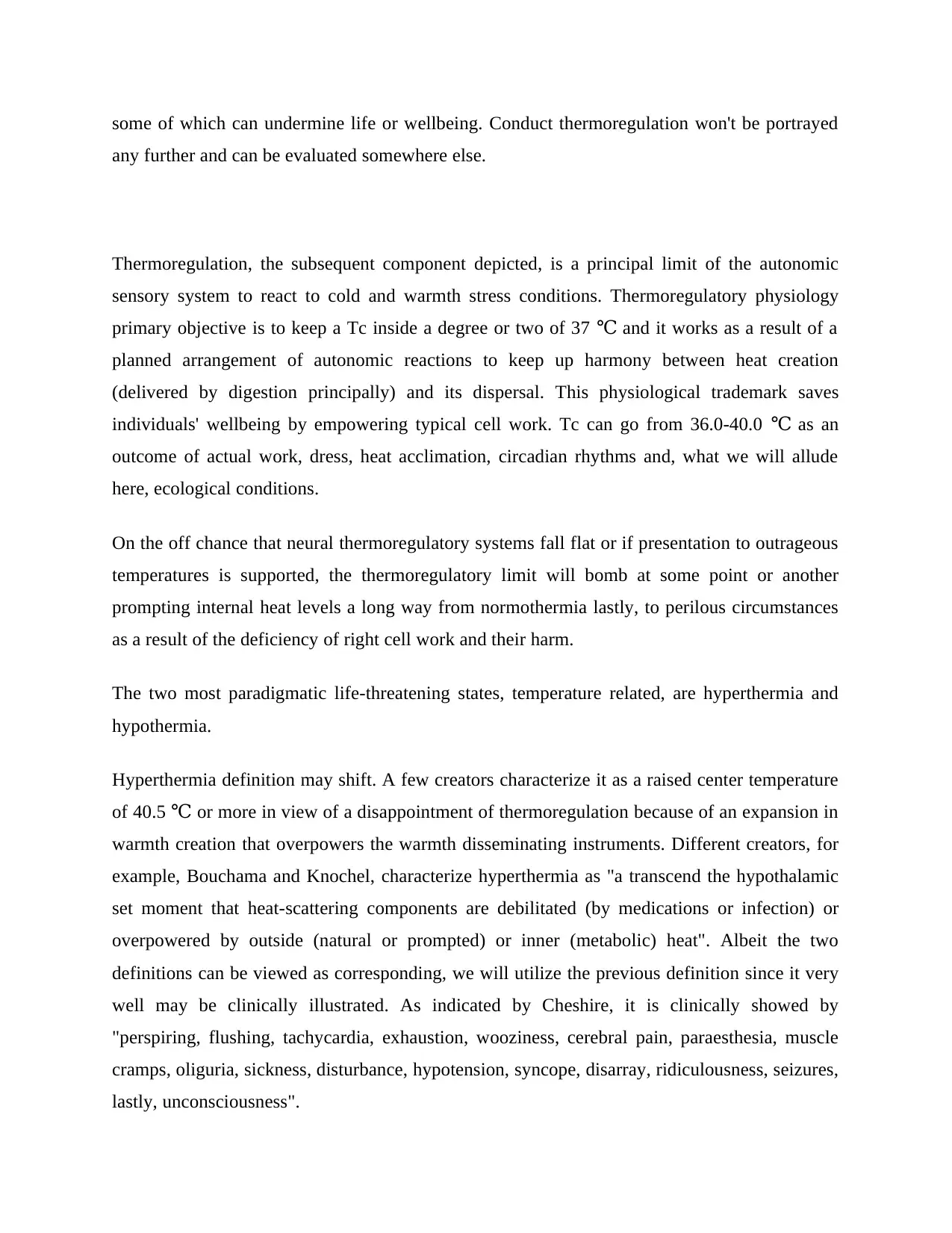
some of which can undermine life or wellbeing. Conduct thermoregulation won't be portrayed
any further and can be evaluated somewhere else.
Thermoregulation, the subsequent component depicted, is a principal limit of the autonomic
sensory system to react to cold and warmth stress conditions. Thermoregulatory physiology
primary objective is to keep a Tc inside a degree or two of 37 and it works as a result of a℃
planned arrangement of autonomic reactions to keep up harmony between heat creation
(delivered by digestion principally) and its dispersal. This physiological trademark saves
individuals' wellbeing by empowering typical cell work. Tc can go from 36.0-40.0 as an℃
outcome of actual work, dress, heat acclimation, circadian rhythms and, what we will allude
here, ecological conditions.
On the off chance that neural thermoregulatory systems fall flat or if presentation to outrageous
temperatures is supported, the thermoregulatory limit will bomb at some point or another
prompting internal heat levels a long way from normothermia lastly, to perilous circumstances
as a result of the deficiency of right cell work and their harm.
The two most paradigmatic life-threatening states, temperature related, are hyperthermia and
hypothermia.
Hyperthermia definition may shift. A few creators characterize it as a raised center temperature
of 40.5 or more in view of a disappointment of thermoregulation because of an expansion in℃
warmth creation that overpowers the warmth disseminating instruments. Different creators, for
example, Bouchama and Knochel, characterize hyperthermia as "a transcend the hypothalamic
set moment that heat-scattering components are debilitated (by medications or infection) or
overpowered by outside (natural or prompted) or inner (metabolic) heat". Albeit the two
definitions can be viewed as corresponding, we will utilize the previous definition since it very
well may be clinically illustrated. As indicated by Cheshire, it is clinically showed by
"perspiring, flushing, tachycardia, exhaustion, wooziness, cerebral pain, paraesthesia, muscle
cramps, oliguria, sickness, disturbance, hypotension, syncope, disarray, ridiculousness, seizures,
lastly, unconsciousness".
any further and can be evaluated somewhere else.
Thermoregulation, the subsequent component depicted, is a principal limit of the autonomic
sensory system to react to cold and warmth stress conditions. Thermoregulatory physiology
primary objective is to keep a Tc inside a degree or two of 37 and it works as a result of a℃
planned arrangement of autonomic reactions to keep up harmony between heat creation
(delivered by digestion principally) and its dispersal. This physiological trademark saves
individuals' wellbeing by empowering typical cell work. Tc can go from 36.0-40.0 as an℃
outcome of actual work, dress, heat acclimation, circadian rhythms and, what we will allude
here, ecological conditions.
On the off chance that neural thermoregulatory systems fall flat or if presentation to outrageous
temperatures is supported, the thermoregulatory limit will bomb at some point or another
prompting internal heat levels a long way from normothermia lastly, to perilous circumstances
as a result of the deficiency of right cell work and their harm.
The two most paradigmatic life-threatening states, temperature related, are hyperthermia and
hypothermia.
Hyperthermia definition may shift. A few creators characterize it as a raised center temperature
of 40.5 or more in view of a disappointment of thermoregulation because of an expansion in℃
warmth creation that overpowers the warmth disseminating instruments. Different creators, for
example, Bouchama and Knochel, characterize hyperthermia as "a transcend the hypothalamic
set moment that heat-scattering components are debilitated (by medications or infection) or
overpowered by outside (natural or prompted) or inner (metabolic) heat". Albeit the two
definitions can be viewed as corresponding, we will utilize the previous definition since it very
well may be clinically illustrated. As indicated by Cheshire, it is clinically showed by
"perspiring, flushing, tachycardia, exhaustion, wooziness, cerebral pain, paraesthesia, muscle
cramps, oliguria, sickness, disturbance, hypotension, syncope, disarray, ridiculousness, seizures,
lastly, unconsciousness".
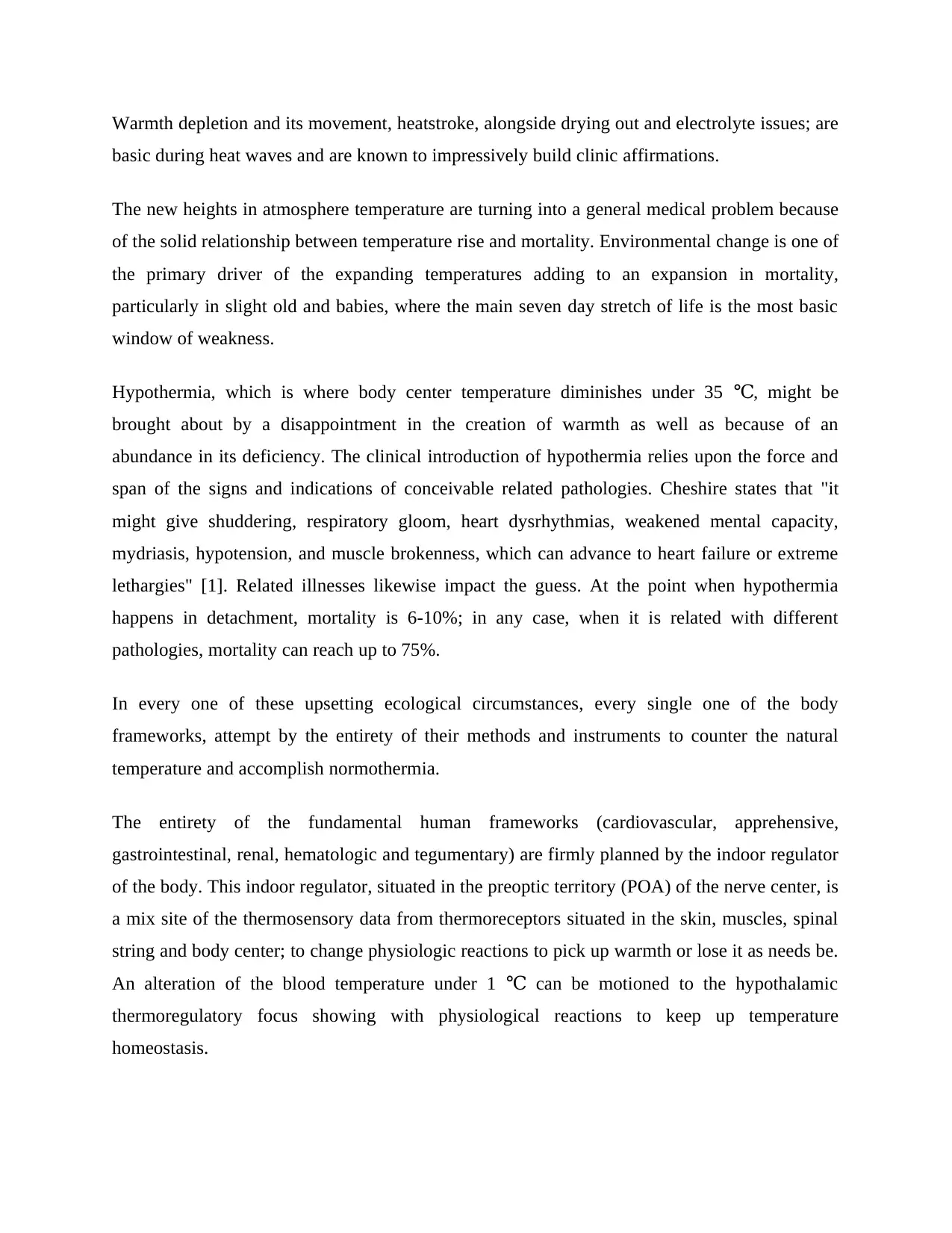
Warmth depletion and its movement, heatstroke, alongside drying out and electrolyte issues; are
basic during heat waves and are known to impressively build clinic affirmations.
The new heights in atmosphere temperature are turning into a general medical problem because
of the solid relationship between temperature rise and mortality. Environmental change is one of
the primary driver of the expanding temperatures adding to an expansion in mortality,
particularly in slight old and babies, where the main seven day stretch of life is the most basic
window of weakness.
Hypothermia, which is where body center temperature diminishes under 35 , might be℃
brought about by a disappointment in the creation of warmth as well as because of an
abundance in its deficiency. The clinical introduction of hypothermia relies upon the force and
span of the signs and indications of conceivable related pathologies. Cheshire states that "it
might give shuddering, respiratory gloom, heart dysrhythmias, weakened mental capacity,
mydriasis, hypotension, and muscle brokenness, which can advance to heart failure or extreme
lethargies" [1]. Related illnesses likewise impact the guess. At the point when hypothermia
happens in detachment, mortality is 6-10%; in any case, when it is related with different
pathologies, mortality can reach up to 75%.
In every one of these upsetting ecological circumstances, every single one of the body
frameworks, attempt by the entirety of their methods and instruments to counter the natural
temperature and accomplish normothermia.
The entirety of the fundamental human frameworks (cardiovascular, apprehensive,
gastrointestinal, renal, hematologic and tegumentary) are firmly planned by the indoor regulator
of the body. This indoor regulator, situated in the preoptic territory (POA) of the nerve center, is
a mix site of the thermosensory data from thermoreceptors situated in the skin, muscles, spinal
string and body center; to change physiologic reactions to pick up warmth or lose it as needs be.
An alteration of the blood temperature under 1 can be motioned to the hypothalamic℃
thermoregulatory focus showing with physiological reactions to keep up temperature
homeostasis.
basic during heat waves and are known to impressively build clinic affirmations.
The new heights in atmosphere temperature are turning into a general medical problem because
of the solid relationship between temperature rise and mortality. Environmental change is one of
the primary driver of the expanding temperatures adding to an expansion in mortality,
particularly in slight old and babies, where the main seven day stretch of life is the most basic
window of weakness.
Hypothermia, which is where body center temperature diminishes under 35 , might be℃
brought about by a disappointment in the creation of warmth as well as because of an
abundance in its deficiency. The clinical introduction of hypothermia relies upon the force and
span of the signs and indications of conceivable related pathologies. Cheshire states that "it
might give shuddering, respiratory gloom, heart dysrhythmias, weakened mental capacity,
mydriasis, hypotension, and muscle brokenness, which can advance to heart failure or extreme
lethargies" [1]. Related illnesses likewise impact the guess. At the point when hypothermia
happens in detachment, mortality is 6-10%; in any case, when it is related with different
pathologies, mortality can reach up to 75%.
In every one of these upsetting ecological circumstances, every single one of the body
frameworks, attempt by the entirety of their methods and instruments to counter the natural
temperature and accomplish normothermia.
The entirety of the fundamental human frameworks (cardiovascular, apprehensive,
gastrointestinal, renal, hematologic and tegumentary) are firmly planned by the indoor regulator
of the body. This indoor regulator, situated in the preoptic territory (POA) of the nerve center, is
a mix site of the thermosensory data from thermoreceptors situated in the skin, muscles, spinal
string and body center; to change physiologic reactions to pick up warmth or lose it as needs be.
An alteration of the blood temperature under 1 can be motioned to the hypothalamic℃
thermoregulatory focus showing with physiological reactions to keep up temperature
homeostasis.
Paraphrase This Document
Need a fresh take? Get an instant paraphrase of this document with our AI Paraphraser
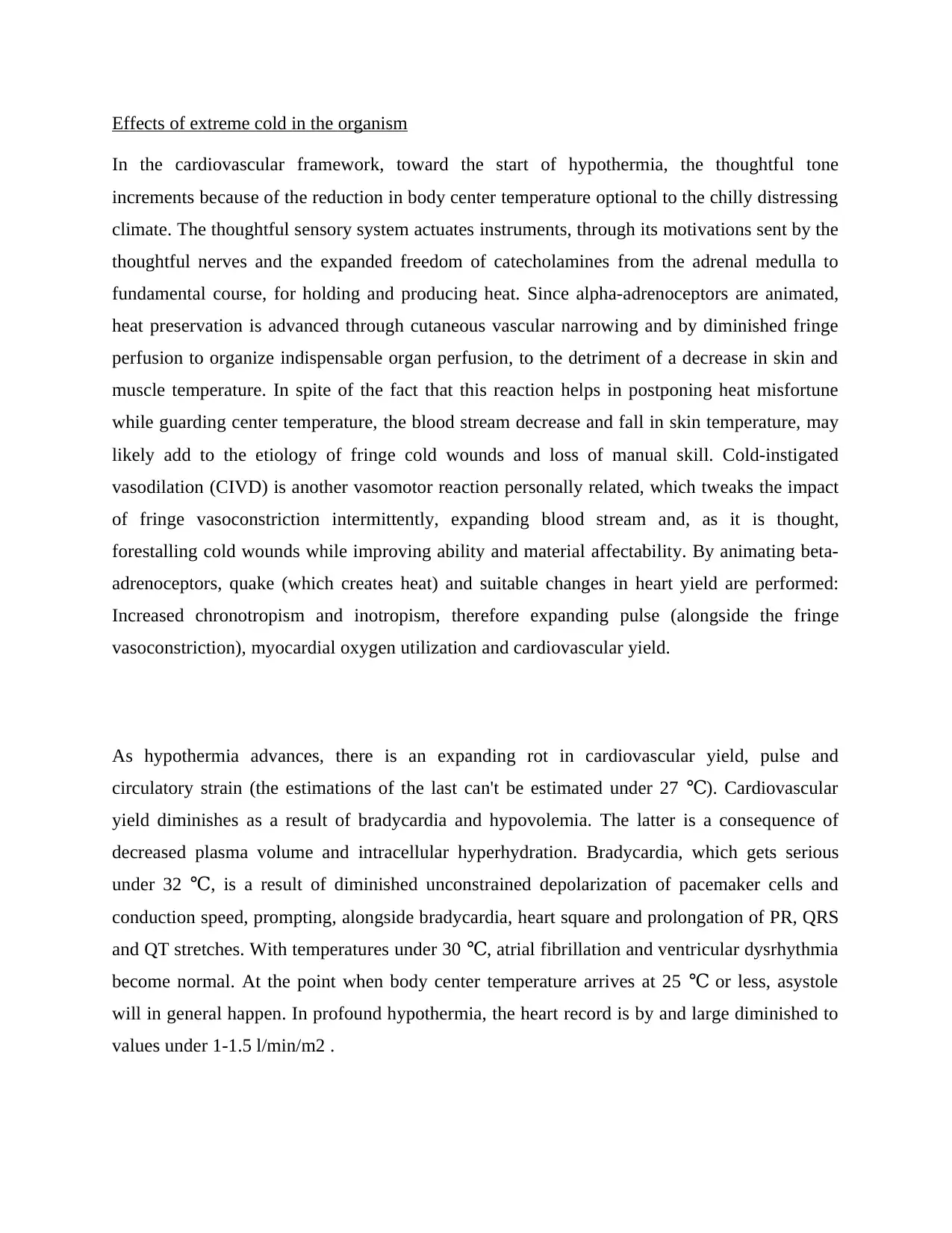
Effects of extreme cold in the organism
In the cardiovascular framework, toward the start of hypothermia, the thoughtful tone
increments because of the reduction in body center temperature optional to the chilly distressing
climate. The thoughtful sensory system actuates instruments, through its motivations sent by the
thoughtful nerves and the expanded freedom of catecholamines from the adrenal medulla to
fundamental course, for holding and producing heat. Since alpha-adrenoceptors are animated,
heat preservation is advanced through cutaneous vascular narrowing and by diminished fringe
perfusion to organize indispensable organ perfusion, to the detriment of a decrease in skin and
muscle temperature. In spite of the fact that this reaction helps in postponing heat misfortune
while guarding center temperature, the blood stream decrease and fall in skin temperature, may
likely add to the etiology of fringe cold wounds and loss of manual skill. Cold-instigated
vasodilation (CIVD) is another vasomotor reaction personally related, which tweaks the impact
of fringe vasoconstriction intermittently, expanding blood stream and, as it is thought,
forestalling cold wounds while improving ability and material affectability. By animating beta-
adrenoceptors, quake (which creates heat) and suitable changes in heart yield are performed:
Increased chronotropism and inotropism, therefore expanding pulse (alongside the fringe
vasoconstriction), myocardial oxygen utilization and cardiovascular yield.
As hypothermia advances, there is an expanding rot in cardiovascular yield, pulse and
circulatory strain (the estimations of the last can't be estimated under 27 ). Cardiovascular℃
yield diminishes as a result of bradycardia and hypovolemia. The latter is a consequence of
decreased plasma volume and intracellular hyperhydration. Bradycardia, which gets serious
under 32 , is a result of diminished unconstrained depolarization of pacemaker cells and℃
conduction speed, prompting, alongside bradycardia, heart square and prolongation of PR, QRS
and QT stretches. With temperatures under 30 , atrial fibrillation and ventricular dysrhythmia℃
become normal. At the point when body center temperature arrives at 25 or less, asystole℃
will in general happen. In profound hypothermia, the heart record is by and large diminished to
values under 1-1.5 l/min/m2 .
In the cardiovascular framework, toward the start of hypothermia, the thoughtful tone
increments because of the reduction in body center temperature optional to the chilly distressing
climate. The thoughtful sensory system actuates instruments, through its motivations sent by the
thoughtful nerves and the expanded freedom of catecholamines from the adrenal medulla to
fundamental course, for holding and producing heat. Since alpha-adrenoceptors are animated,
heat preservation is advanced through cutaneous vascular narrowing and by diminished fringe
perfusion to organize indispensable organ perfusion, to the detriment of a decrease in skin and
muscle temperature. In spite of the fact that this reaction helps in postponing heat misfortune
while guarding center temperature, the blood stream decrease and fall in skin temperature, may
likely add to the etiology of fringe cold wounds and loss of manual skill. Cold-instigated
vasodilation (CIVD) is another vasomotor reaction personally related, which tweaks the impact
of fringe vasoconstriction intermittently, expanding blood stream and, as it is thought,
forestalling cold wounds while improving ability and material affectability. By animating beta-
adrenoceptors, quake (which creates heat) and suitable changes in heart yield are performed:
Increased chronotropism and inotropism, therefore expanding pulse (alongside the fringe
vasoconstriction), myocardial oxygen utilization and cardiovascular yield.
As hypothermia advances, there is an expanding rot in cardiovascular yield, pulse and
circulatory strain (the estimations of the last can't be estimated under 27 ). Cardiovascular℃
yield diminishes as a result of bradycardia and hypovolemia. The latter is a consequence of
decreased plasma volume and intracellular hyperhydration. Bradycardia, which gets serious
under 32 , is a result of diminished unconstrained depolarization of pacemaker cells and℃
conduction speed, prompting, alongside bradycardia, heart square and prolongation of PR, QRS
and QT stretches. With temperatures under 30 , atrial fibrillation and ventricular dysrhythmia℃
become normal. At the point when body center temperature arrives at 25 or less, asystole℃
will in general happen. In profound hypothermia, the heart record is by and large diminished to
values under 1-1.5 l/min/m2 .
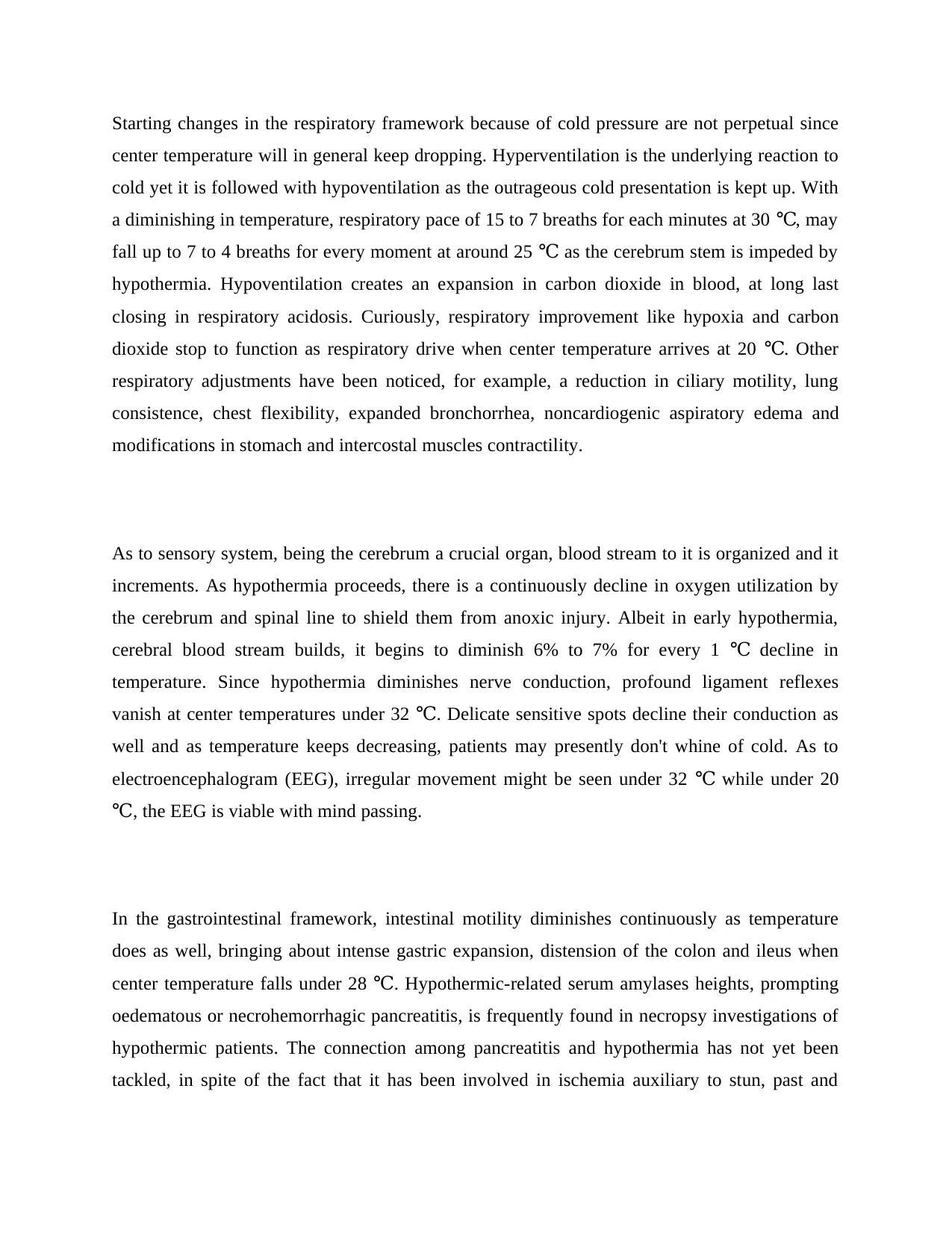
Starting changes in the respiratory framework because of cold pressure are not perpetual since
center temperature will in general keep dropping. Hyperventilation is the underlying reaction to
cold yet it is followed with hypoventilation as the outrageous cold presentation is kept up. With
a diminishing in temperature, respiratory pace of 15 to 7 breaths for each minutes at 30 , may℃
fall up to 7 to 4 breaths for every moment at around 25 as the cerebrum stem is impeded by℃
hypothermia. Hypoventilation creates an expansion in carbon dioxide in blood, at long last
closing in respiratory acidosis. Curiously, respiratory improvement like hypoxia and carbon
dioxide stop to function as respiratory drive when center temperature arrives at 20 . Other℃
respiratory adjustments have been noticed, for example, a reduction in ciliary motility, lung
consistence, chest flexibility, expanded bronchorrhea, noncardiogenic aspiratory edema and
modifications in stomach and intercostal muscles contractility.
As to sensory system, being the cerebrum a crucial organ, blood stream to it is organized and it
increments. As hypothermia proceeds, there is a continuously decline in oxygen utilization by
the cerebrum and spinal line to shield them from anoxic injury. Albeit in early hypothermia,
cerebral blood stream builds, it begins to diminish 6% to 7% for every 1 decline in℃
temperature. Since hypothermia diminishes nerve conduction, profound ligament reflexes
vanish at center temperatures under 32 . Delicate sensitive spots decline their conduction as℃
well and as temperature keeps decreasing, patients may presently don't whine of cold. As to
electroencephalogram (EEG), irregular movement might be seen under 32 while under 20℃
, the EEG is viable with mind passing.℃
In the gastrointestinal framework, intestinal motility diminishes continuously as temperature
does as well, bringing about intense gastric expansion, distension of the colon and ileus when
center temperature falls under 28 . Hypothermic-related serum amylases heights, prompting℃
oedematous or necrohemorrhagic pancreatitis, is frequently found in necropsy investigations of
hypothermic patients. The connection among pancreatitis and hypothermia has not yet been
tackled, in spite of the fact that it has been involved in ischemia auxiliary to stun, past and
center temperature will in general keep dropping. Hyperventilation is the underlying reaction to
cold yet it is followed with hypoventilation as the outrageous cold presentation is kept up. With
a diminishing in temperature, respiratory pace of 15 to 7 breaths for each minutes at 30 , may℃
fall up to 7 to 4 breaths for every moment at around 25 as the cerebrum stem is impeded by℃
hypothermia. Hypoventilation creates an expansion in carbon dioxide in blood, at long last
closing in respiratory acidosis. Curiously, respiratory improvement like hypoxia and carbon
dioxide stop to function as respiratory drive when center temperature arrives at 20 . Other℃
respiratory adjustments have been noticed, for example, a reduction in ciliary motility, lung
consistence, chest flexibility, expanded bronchorrhea, noncardiogenic aspiratory edema and
modifications in stomach and intercostal muscles contractility.
As to sensory system, being the cerebrum a crucial organ, blood stream to it is organized and it
increments. As hypothermia proceeds, there is a continuously decline in oxygen utilization by
the cerebrum and spinal line to shield them from anoxic injury. Albeit in early hypothermia,
cerebral blood stream builds, it begins to diminish 6% to 7% for every 1 decline in℃
temperature. Since hypothermia diminishes nerve conduction, profound ligament reflexes
vanish at center temperatures under 32 . Delicate sensitive spots decline their conduction as℃
well and as temperature keeps decreasing, patients may presently don't whine of cold. As to
electroencephalogram (EEG), irregular movement might be seen under 32 while under 20℃
, the EEG is viable with mind passing.℃
In the gastrointestinal framework, intestinal motility diminishes continuously as temperature
does as well, bringing about intense gastric expansion, distension of the colon and ileus when
center temperature falls under 28 . Hypothermic-related serum amylases heights, prompting℃
oedematous or necrohemorrhagic pancreatitis, is frequently found in necropsy investigations of
hypothermic patients. The connection among pancreatitis and hypothermia has not yet been
tackled, in spite of the fact that it has been involved in ischemia auxiliary to stun, past and
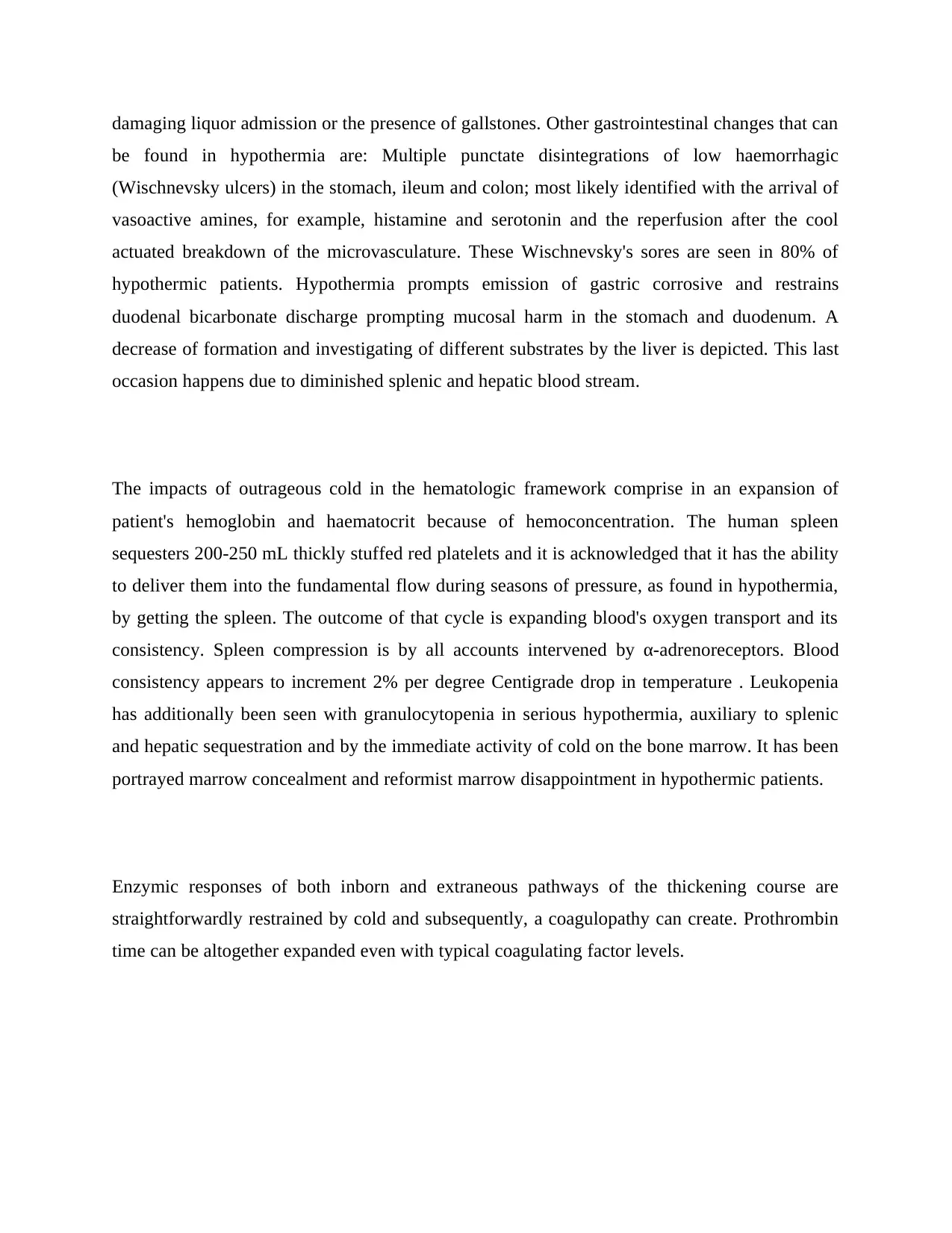
damaging liquor admission or the presence of gallstones. Other gastrointestinal changes that can
be found in hypothermia are: Multiple punctate disintegrations of low haemorrhagic
(Wischnevsky ulcers) in the stomach, ileum and colon; most likely identified with the arrival of
vasoactive amines, for example, histamine and serotonin and the reperfusion after the cool
actuated breakdown of the microvasculature. These Wischnevsky's sores are seen in 80% of
hypothermic patients. Hypothermia prompts emission of gastric corrosive and restrains
duodenal bicarbonate discharge prompting mucosal harm in the stomach and duodenum. A
decrease of formation and investigating of different substrates by the liver is depicted. This last
occasion happens due to diminished splenic and hepatic blood stream.
The impacts of outrageous cold in the hematologic framework comprise in an expansion of
patient's hemoglobin and haematocrit because of hemoconcentration. The human spleen
sequesters 200-250 mL thickly stuffed red platelets and it is acknowledged that it has the ability
to deliver them into the fundamental flow during seasons of pressure, as found in hypothermia,
by getting the spleen. The outcome of that cycle is expanding blood's oxygen transport and its
consistency. Spleen compression is by all accounts intervened by α-adrenoreceptors. Blood
consistency appears to increment 2% per degree Centigrade drop in temperature . Leukopenia
has additionally been seen with granulocytopenia in serious hypothermia, auxiliary to splenic
and hepatic sequestration and by the immediate activity of cold on the bone marrow. It has been
portrayed marrow concealment and reformist marrow disappointment in hypothermic patients.
Enzymic responses of both inborn and extraneous pathways of the thickening course are
straightforwardly restrained by cold and subsequently, a coagulopathy can create. Prothrombin
time can be altogether expanded even with typical coagulating factor levels.
be found in hypothermia are: Multiple punctate disintegrations of low haemorrhagic
(Wischnevsky ulcers) in the stomach, ileum and colon; most likely identified with the arrival of
vasoactive amines, for example, histamine and serotonin and the reperfusion after the cool
actuated breakdown of the microvasculature. These Wischnevsky's sores are seen in 80% of
hypothermic patients. Hypothermia prompts emission of gastric corrosive and restrains
duodenal bicarbonate discharge prompting mucosal harm in the stomach and duodenum. A
decrease of formation and investigating of different substrates by the liver is depicted. This last
occasion happens due to diminished splenic and hepatic blood stream.
The impacts of outrageous cold in the hematologic framework comprise in an expansion of
patient's hemoglobin and haematocrit because of hemoconcentration. The human spleen
sequesters 200-250 mL thickly stuffed red platelets and it is acknowledged that it has the ability
to deliver them into the fundamental flow during seasons of pressure, as found in hypothermia,
by getting the spleen. The outcome of that cycle is expanding blood's oxygen transport and its
consistency. Spleen compression is by all accounts intervened by α-adrenoreceptors. Blood
consistency appears to increment 2% per degree Centigrade drop in temperature . Leukopenia
has additionally been seen with granulocytopenia in serious hypothermia, auxiliary to splenic
and hepatic sequestration and by the immediate activity of cold on the bone marrow. It has been
portrayed marrow concealment and reformist marrow disappointment in hypothermic patients.
Enzymic responses of both inborn and extraneous pathways of the thickening course are
straightforwardly restrained by cold and subsequently, a coagulopathy can create. Prothrombin
time can be altogether expanded even with typical coagulating factor levels.
Secure Best Marks with AI Grader
Need help grading? Try our AI Grader for instant feedback on your assignments.
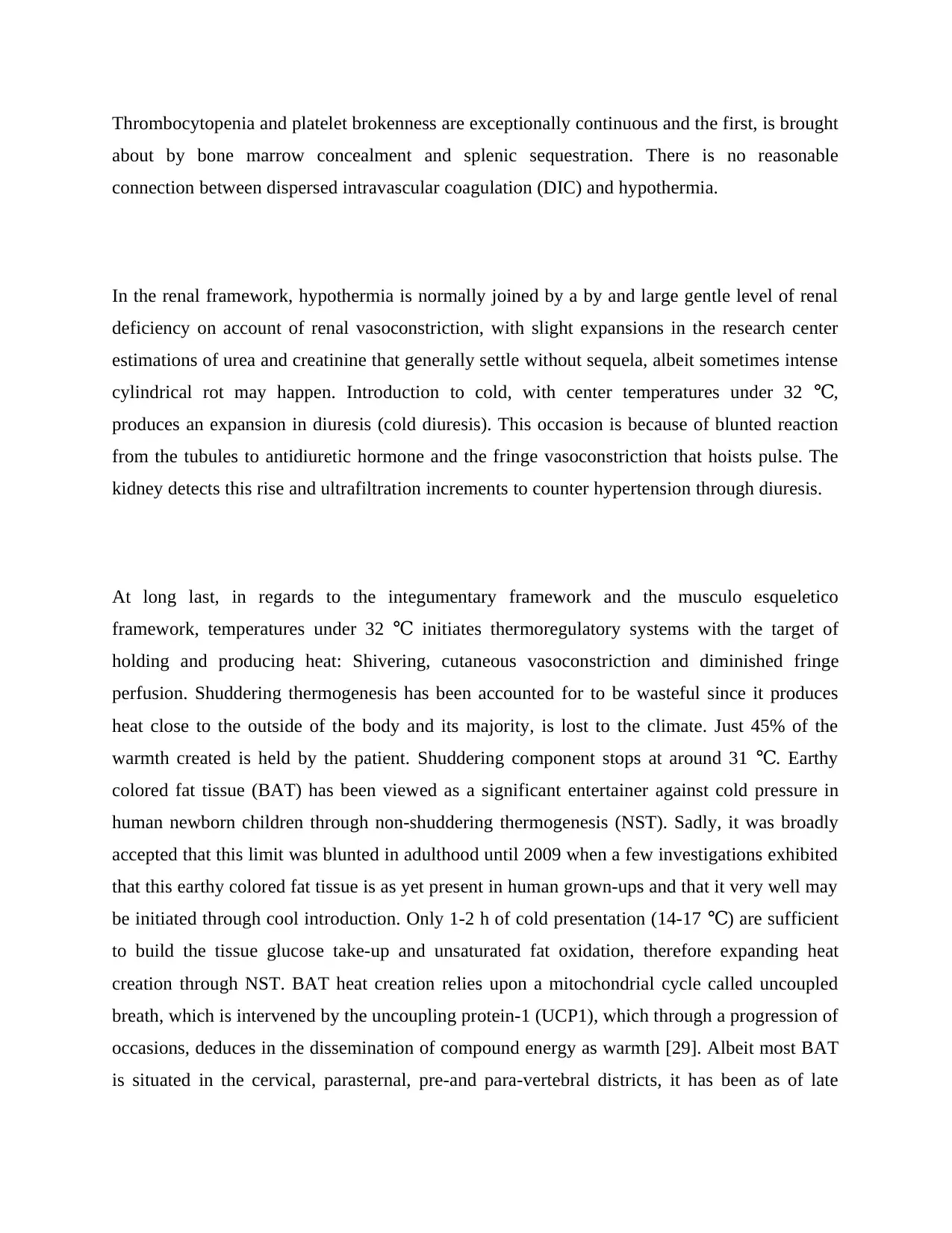
Thrombocytopenia and platelet brokenness are exceptionally continuous and the first, is brought
about by bone marrow concealment and splenic sequestration. There is no reasonable
connection between dispersed intravascular coagulation (DIC) and hypothermia.
In the renal framework, hypothermia is normally joined by a by and large gentle level of renal
deficiency on account of renal vasoconstriction, with slight expansions in the research center
estimations of urea and creatinine that generally settle without sequela, albeit sometimes intense
cylindrical rot may happen. Introduction to cold, with center temperatures under 32 ,℃
produces an expansion in diuresis (cold diuresis). This occasion is because of blunted reaction
from the tubules to antidiuretic hormone and the fringe vasoconstriction that hoists pulse. The
kidney detects this rise and ultrafiltration increments to counter hypertension through diuresis.
At long last, in regards to the integumentary framework and the musculo esqueletico
framework, temperatures under 32 initiates thermoregulatory systems with the target of℃
holding and producing heat: Shivering, cutaneous vasoconstriction and diminished fringe
perfusion. Shuddering thermogenesis has been accounted for to be wasteful since it produces
heat close to the outside of the body and its majority, is lost to the climate. Just 45% of the
warmth created is held by the patient. Shuddering component stops at around 31 . Earthy℃
colored fat tissue (BAT) has been viewed as a significant entertainer against cold pressure in
human newborn children through non-shuddering thermogenesis (NST). Sadly, it was broadly
accepted that this limit was blunted in adulthood until 2009 when a few investigations exhibited
that this earthy colored fat tissue is as yet present in human grown-ups and that it very well may
be initiated through cool introduction. Only 1-2 h of cold presentation (14-17 ) are sufficient℃
to build the tissue glucose take-up and unsaturated fat oxidation, therefore expanding heat
creation through NST. BAT heat creation relies upon a mitochondrial cycle called uncoupled
breath, which is intervened by the uncoupling protein-1 (UCP1), which through a progression of
occasions, deduces in the dissemination of compound energy as warmth [29]. Albeit most BAT
is situated in the cervical, parasternal, pre-and para-vertebral districts, it has been as of late
about by bone marrow concealment and splenic sequestration. There is no reasonable
connection between dispersed intravascular coagulation (DIC) and hypothermia.
In the renal framework, hypothermia is normally joined by a by and large gentle level of renal
deficiency on account of renal vasoconstriction, with slight expansions in the research center
estimations of urea and creatinine that generally settle without sequela, albeit sometimes intense
cylindrical rot may happen. Introduction to cold, with center temperatures under 32 ,℃
produces an expansion in diuresis (cold diuresis). This occasion is because of blunted reaction
from the tubules to antidiuretic hormone and the fringe vasoconstriction that hoists pulse. The
kidney detects this rise and ultrafiltration increments to counter hypertension through diuresis.
At long last, in regards to the integumentary framework and the musculo esqueletico
framework, temperatures under 32 initiates thermoregulatory systems with the target of℃
holding and producing heat: Shivering, cutaneous vasoconstriction and diminished fringe
perfusion. Shuddering thermogenesis has been accounted for to be wasteful since it produces
heat close to the outside of the body and its majority, is lost to the climate. Just 45% of the
warmth created is held by the patient. Shuddering component stops at around 31 . Earthy℃
colored fat tissue (BAT) has been viewed as a significant entertainer against cold pressure in
human newborn children through non-shuddering thermogenesis (NST). Sadly, it was broadly
accepted that this limit was blunted in adulthood until 2009 when a few investigations exhibited
that this earthy colored fat tissue is as yet present in human grown-ups and that it very well may
be initiated through cool introduction. Only 1-2 h of cold presentation (14-17 ) are sufficient℃
to build the tissue glucose take-up and unsaturated fat oxidation, therefore expanding heat
creation through NST. BAT heat creation relies upon a mitochondrial cycle called uncoupled
breath, which is intervened by the uncoupling protein-1 (UCP1), which through a progression of
occasions, deduces in the dissemination of compound energy as warmth [29]. Albeit most BAT
is situated in the cervical, parasternal, pre-and para-vertebral districts, it has been as of late
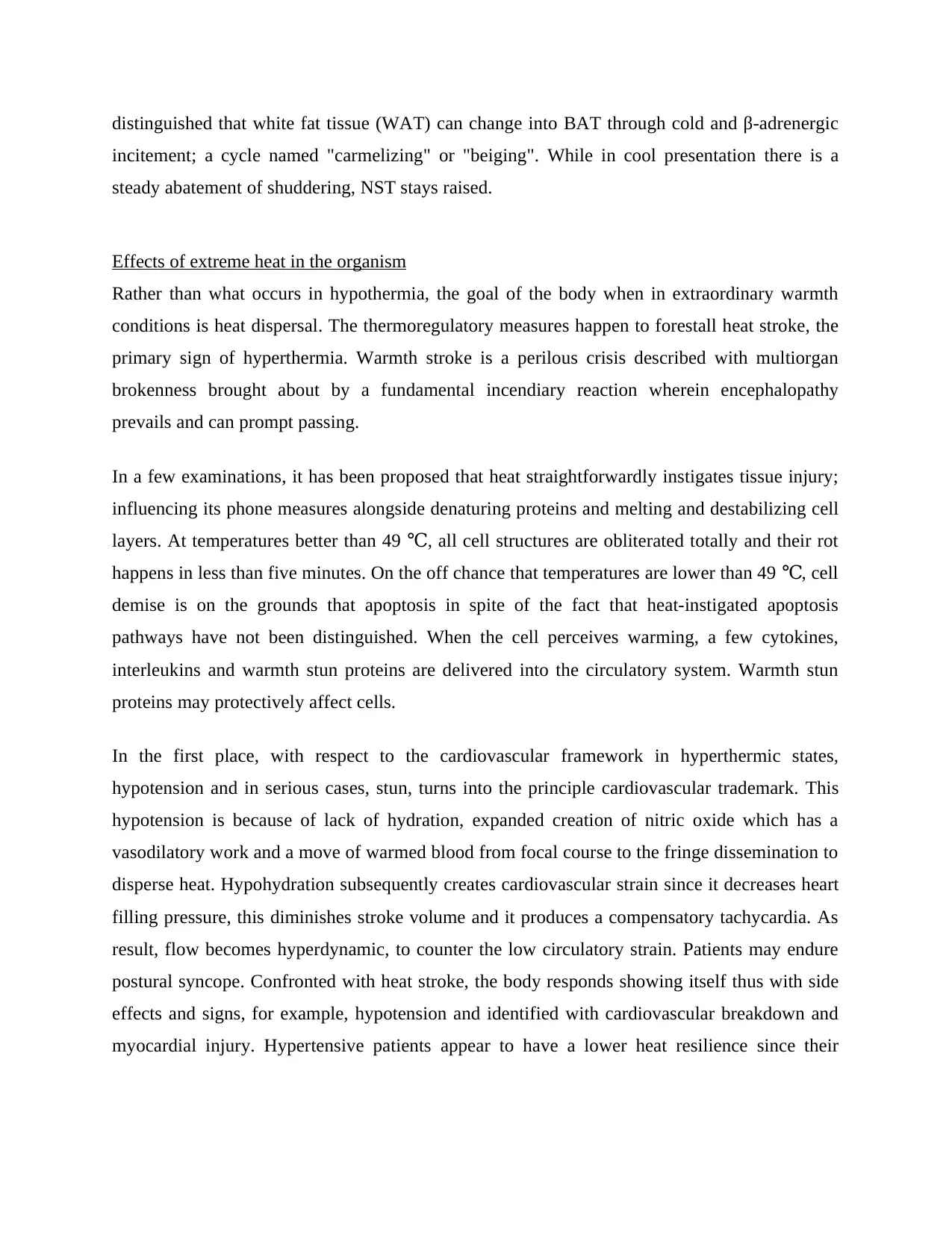
distinguished that white fat tissue (WAT) can change into BAT through cold and β-adrenergic
incitement; a cycle named "carmelizing" or "beiging". While in cool presentation there is a
steady abatement of shuddering, NST stays raised.
Effects of extreme heat in the organism
Rather than what occurs in hypothermia, the goal of the body when in extraordinary warmth
conditions is heat dispersal. The thermoregulatory measures happen to forestall heat stroke, the
primary sign of hyperthermia. Warmth stroke is a perilous crisis described with multiorgan
brokenness brought about by a fundamental incendiary reaction wherein encephalopathy
prevails and can prompt passing.
In a few examinations, it has been proposed that heat straightforwardly instigates tissue injury;
influencing its phone measures alongside denaturing proteins and melting and destabilizing cell
layers. At temperatures better than 49 , all cell structures are obliterated totally and their rot℃
happens in less than five minutes. On the off chance that temperatures are lower than 49 , cell℃
demise is on the grounds that apoptosis in spite of the fact that heat-instigated apoptosis
pathways have not been distinguished. When the cell perceives warming, a few cytokines,
interleukins and warmth stun proteins are delivered into the circulatory system. Warmth stun
proteins may protectively affect cells.
In the first place, with respect to the cardiovascular framework in hyperthermic states,
hypotension and in serious cases, stun, turns into the principle cardiovascular trademark. This
hypotension is because of lack of hydration, expanded creation of nitric oxide which has a
vasodilatory work and a move of warmed blood from focal course to the fringe dissemination to
disperse heat. Hypohydration subsequently creates cardiovascular strain since it decreases heart
filling pressure, this diminishes stroke volume and it produces a compensatory tachycardia. As
result, flow becomes hyperdynamic, to counter the low circulatory strain. Patients may endure
postural syncope. Confronted with heat stroke, the body responds showing itself thus with side
effects and signs, for example, hypotension and identified with cardiovascular breakdown and
myocardial injury. Hypertensive patients appear to have a lower heat resilience since their
incitement; a cycle named "carmelizing" or "beiging". While in cool presentation there is a
steady abatement of shuddering, NST stays raised.
Effects of extreme heat in the organism
Rather than what occurs in hypothermia, the goal of the body when in extraordinary warmth
conditions is heat dispersal. The thermoregulatory measures happen to forestall heat stroke, the
primary sign of hyperthermia. Warmth stroke is a perilous crisis described with multiorgan
brokenness brought about by a fundamental incendiary reaction wherein encephalopathy
prevails and can prompt passing.
In a few examinations, it has been proposed that heat straightforwardly instigates tissue injury;
influencing its phone measures alongside denaturing proteins and melting and destabilizing cell
layers. At temperatures better than 49 , all cell structures are obliterated totally and their rot℃
happens in less than five minutes. On the off chance that temperatures are lower than 49 , cell℃
demise is on the grounds that apoptosis in spite of the fact that heat-instigated apoptosis
pathways have not been distinguished. When the cell perceives warming, a few cytokines,
interleukins and warmth stun proteins are delivered into the circulatory system. Warmth stun
proteins may protectively affect cells.
In the first place, with respect to the cardiovascular framework in hyperthermic states,
hypotension and in serious cases, stun, turns into the principle cardiovascular trademark. This
hypotension is because of lack of hydration, expanded creation of nitric oxide which has a
vasodilatory work and a move of warmed blood from focal course to the fringe dissemination to
disperse heat. Hypohydration subsequently creates cardiovascular strain since it decreases heart
filling pressure, this diminishes stroke volume and it produces a compensatory tachycardia. As
result, flow becomes hyperdynamic, to counter the low circulatory strain. Patients may endure
postural syncope. Confronted with heat stroke, the body responds showing itself thus with side
effects and signs, for example, hypotension and identified with cardiovascular breakdown and
myocardial injury. Hypertensive patients appear to have a lower heat resilience since their
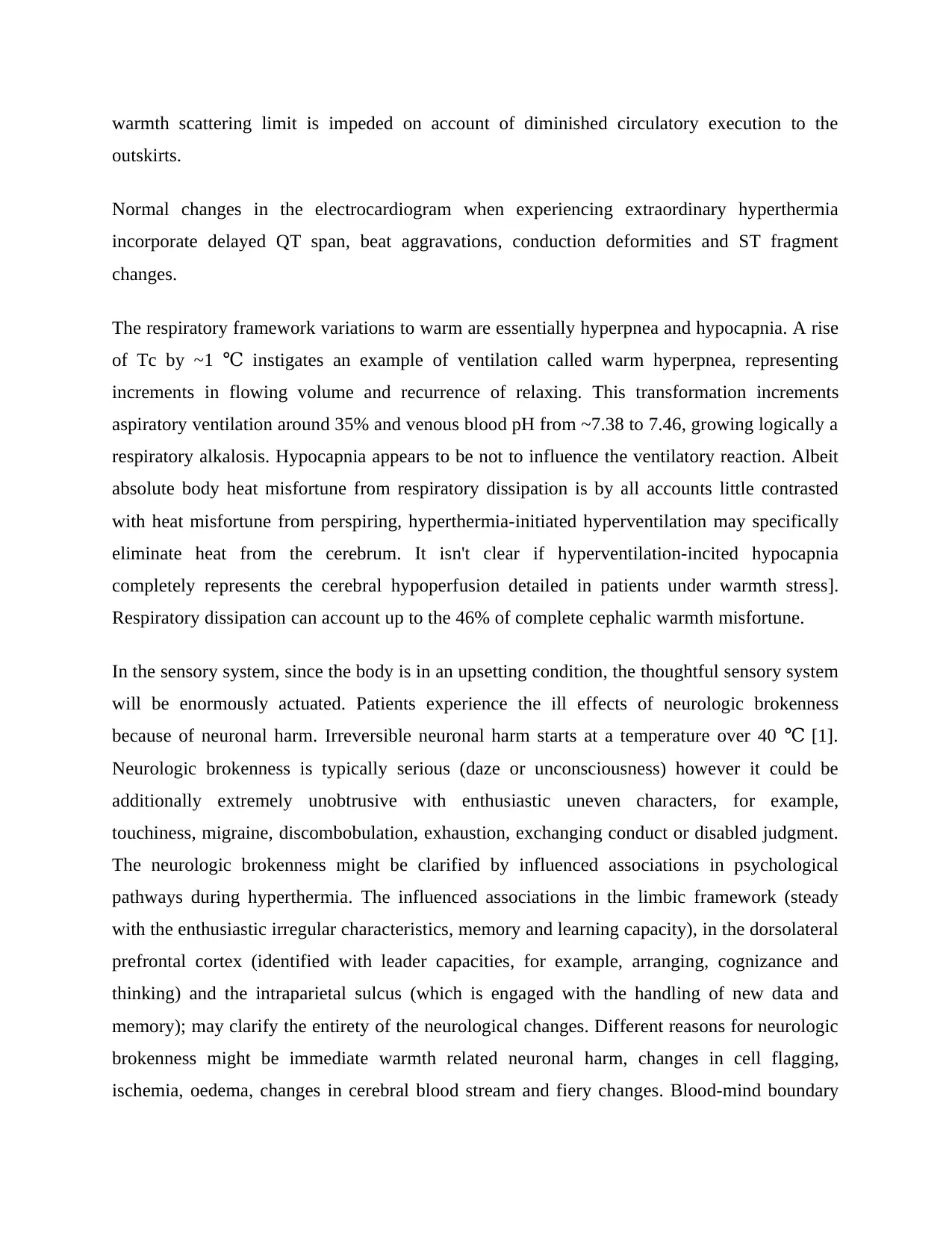
warmth scattering limit is impeded on account of diminished circulatory execution to the
outskirts.
Normal changes in the electrocardiogram when experiencing extraordinary hyperthermia
incorporate delayed QT span, beat aggravations, conduction deformities and ST fragment
changes.
The respiratory framework variations to warm are essentially hyperpnea and hypocapnia. A rise
of Tc by ~1 instigates an example of ventilation called warm hyperpnea, representing℃
increments in flowing volume and recurrence of relaxing. This transformation increments
aspiratory ventilation around 35% and venous blood pH from ~7.38 to 7.46, growing logically a
respiratory alkalosis. Hypocapnia appears to be not to influence the ventilatory reaction. Albeit
absolute body heat misfortune from respiratory dissipation is by all accounts little contrasted
with heat misfortune from perspiring, hyperthermia-initiated hyperventilation may specifically
eliminate heat from the cerebrum. It isn't clear if hyperventilation-incited hypocapnia
completely represents the cerebral hypoperfusion detailed in patients under warmth stress].
Respiratory dissipation can account up to the 46% of complete cephalic warmth misfortune.
In the sensory system, since the body is in an upsetting condition, the thoughtful sensory system
will be enormously actuated. Patients experience the ill effects of neurologic brokenness
because of neuronal harm. Irreversible neuronal harm starts at a temperature over 40 [1].℃
Neurologic brokenness is typically serious (daze or unconsciousness) however it could be
additionally extremely unobtrusive with enthusiastic uneven characters, for example,
touchiness, migraine, discombobulation, exhaustion, exchanging conduct or disabled judgment.
The neurologic brokenness might be clarified by influenced associations in psychological
pathways during hyperthermia. The influenced associations in the limbic framework (steady
with the enthusiastic irregular characteristics, memory and learning capacity), in the dorsolateral
prefrontal cortex (identified with leader capacities, for example, arranging, cognizance and
thinking) and the intraparietal sulcus (which is engaged with the handling of new data and
memory); may clarify the entirety of the neurological changes. Different reasons for neurologic
brokenness might be immediate warmth related neuronal harm, changes in cell flagging,
ischemia, oedema, changes in cerebral blood stream and fiery changes. Blood-mind boundary
outskirts.
Normal changes in the electrocardiogram when experiencing extraordinary hyperthermia
incorporate delayed QT span, beat aggravations, conduction deformities and ST fragment
changes.
The respiratory framework variations to warm are essentially hyperpnea and hypocapnia. A rise
of Tc by ~1 instigates an example of ventilation called warm hyperpnea, representing℃
increments in flowing volume and recurrence of relaxing. This transformation increments
aspiratory ventilation around 35% and venous blood pH from ~7.38 to 7.46, growing logically a
respiratory alkalosis. Hypocapnia appears to be not to influence the ventilatory reaction. Albeit
absolute body heat misfortune from respiratory dissipation is by all accounts little contrasted
with heat misfortune from perspiring, hyperthermia-initiated hyperventilation may specifically
eliminate heat from the cerebrum. It isn't clear if hyperventilation-incited hypocapnia
completely represents the cerebral hypoperfusion detailed in patients under warmth stress].
Respiratory dissipation can account up to the 46% of complete cephalic warmth misfortune.
In the sensory system, since the body is in an upsetting condition, the thoughtful sensory system
will be enormously actuated. Patients experience the ill effects of neurologic brokenness
because of neuronal harm. Irreversible neuronal harm starts at a temperature over 40 [1].℃
Neurologic brokenness is typically serious (daze or unconsciousness) however it could be
additionally extremely unobtrusive with enthusiastic uneven characters, for example,
touchiness, migraine, discombobulation, exhaustion, exchanging conduct or disabled judgment.
The neurologic brokenness might be clarified by influenced associations in psychological
pathways during hyperthermia. The influenced associations in the limbic framework (steady
with the enthusiastic irregular characteristics, memory and learning capacity), in the dorsolateral
prefrontal cortex (identified with leader capacities, for example, arranging, cognizance and
thinking) and the intraparietal sulcus (which is engaged with the handling of new data and
memory); may clarify the entirety of the neurological changes. Different reasons for neurologic
brokenness might be immediate warmth related neuronal harm, changes in cell flagging,
ischemia, oedema, changes in cerebral blood stream and fiery changes. Blood-mind boundary
Paraphrase This Document
Need a fresh take? Get an instant paraphrase of this document with our AI Paraphraser
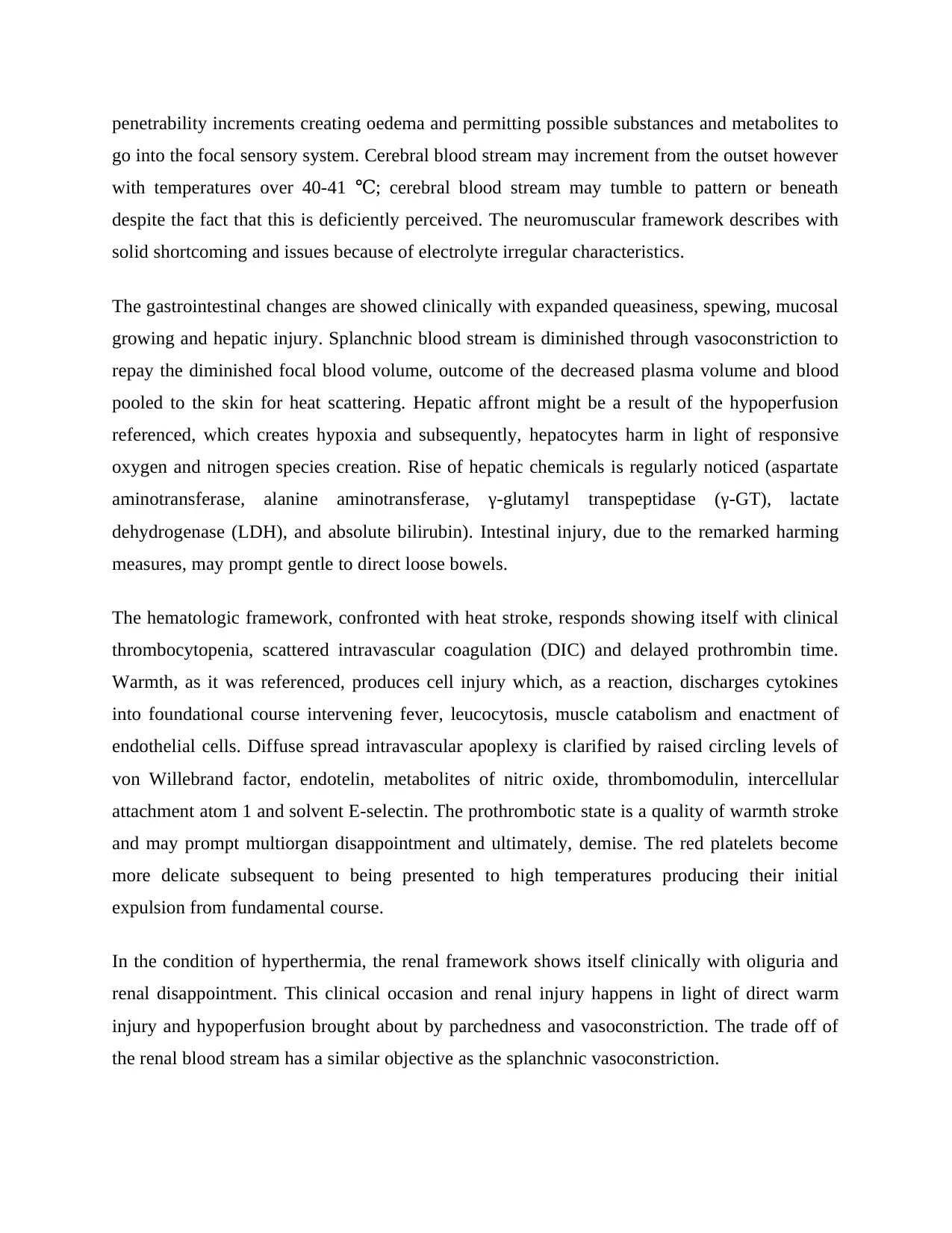
penetrability increments creating oedema and permitting possible substances and metabolites to
go into the focal sensory system. Cerebral blood stream may increment from the outset however
with temperatures over 40-41 ; cerebral blood stream may tumble to pattern or beneath℃
despite the fact that this is deficiently perceived. The neuromuscular framework describes with
solid shortcoming and issues because of electrolyte irregular characteristics.
The gastrointestinal changes are showed clinically with expanded queasiness, spewing, mucosal
growing and hepatic injury. Splanchnic blood stream is diminished through vasoconstriction to
repay the diminished focal blood volume, outcome of the decreased plasma volume and blood
pooled to the skin for heat scattering. Hepatic affront might be a result of the hypoperfusion
referenced, which creates hypoxia and subsequently, hepatocytes harm in light of responsive
oxygen and nitrogen species creation. Rise of hepatic chemicals is regularly noticed (aspartate
aminotransferase, alanine aminotransferase, γ-glutamyl transpeptidase (γ-GT), lactate
dehydrogenase (LDH), and absolute bilirubin). Intestinal injury, due to the remarked harming
measures, may prompt gentle to direct loose bowels.
The hematologic framework, confronted with heat stroke, responds showing itself with clinical
thrombocytopenia, scattered intravascular coagulation (DIC) and delayed prothrombin time.
Warmth, as it was referenced, produces cell injury which, as a reaction, discharges cytokines
into foundational course intervening fever, leucocytosis, muscle catabolism and enactment of
endothelial cells. Diffuse spread intravascular apoplexy is clarified by raised circling levels of
von Willebrand factor, endotelin, metabolites of nitric oxide, thrombomodulin, intercellular
attachment atom 1 and solvent E-selectin. The prothrombotic state is a quality of warmth stroke
and may prompt multiorgan disappointment and ultimately, demise. The red platelets become
more delicate subsequent to being presented to high temperatures producing their initial
expulsion from fundamental course.
In the condition of hyperthermia, the renal framework shows itself clinically with oliguria and
renal disappointment. This clinical occasion and renal injury happens in light of direct warm
injury and hypoperfusion brought about by parchedness and vasoconstriction. The trade off of
the renal blood stream has a similar objective as the splanchnic vasoconstriction.
go into the focal sensory system. Cerebral blood stream may increment from the outset however
with temperatures over 40-41 ; cerebral blood stream may tumble to pattern or beneath℃
despite the fact that this is deficiently perceived. The neuromuscular framework describes with
solid shortcoming and issues because of electrolyte irregular characteristics.
The gastrointestinal changes are showed clinically with expanded queasiness, spewing, mucosal
growing and hepatic injury. Splanchnic blood stream is diminished through vasoconstriction to
repay the diminished focal blood volume, outcome of the decreased plasma volume and blood
pooled to the skin for heat scattering. Hepatic affront might be a result of the hypoperfusion
referenced, which creates hypoxia and subsequently, hepatocytes harm in light of responsive
oxygen and nitrogen species creation. Rise of hepatic chemicals is regularly noticed (aspartate
aminotransferase, alanine aminotransferase, γ-glutamyl transpeptidase (γ-GT), lactate
dehydrogenase (LDH), and absolute bilirubin). Intestinal injury, due to the remarked harming
measures, may prompt gentle to direct loose bowels.
The hematologic framework, confronted with heat stroke, responds showing itself with clinical
thrombocytopenia, scattered intravascular coagulation (DIC) and delayed prothrombin time.
Warmth, as it was referenced, produces cell injury which, as a reaction, discharges cytokines
into foundational course intervening fever, leucocytosis, muscle catabolism and enactment of
endothelial cells. Diffuse spread intravascular apoplexy is clarified by raised circling levels of
von Willebrand factor, endotelin, metabolites of nitric oxide, thrombomodulin, intercellular
attachment atom 1 and solvent E-selectin. The prothrombotic state is a quality of warmth stroke
and may prompt multiorgan disappointment and ultimately, demise. The red platelets become
more delicate subsequent to being presented to high temperatures producing their initial
expulsion from fundamental course.
In the condition of hyperthermia, the renal framework shows itself clinically with oliguria and
renal disappointment. This clinical occasion and renal injury happens in light of direct warm
injury and hypoperfusion brought about by parchedness and vasoconstriction. The trade off of
the renal blood stream has a similar objective as the splanchnic vasoconstriction.
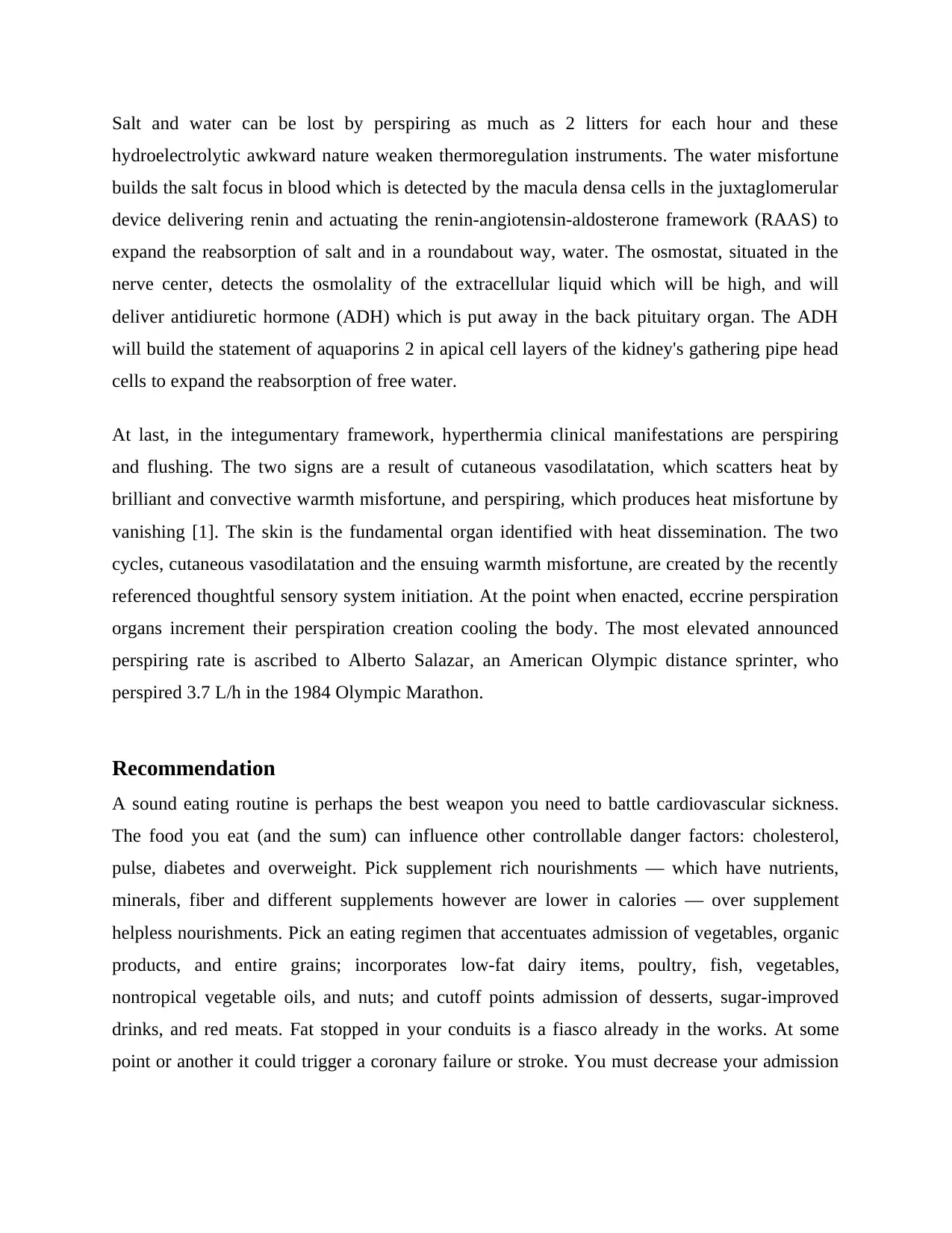
Salt and water can be lost by perspiring as much as 2 litters for each hour and these
hydroelectrolytic awkward nature weaken thermoregulation instruments. The water misfortune
builds the salt focus in blood which is detected by the macula densa cells in the juxtaglomerular
device delivering renin and actuating the renin-angiotensin-aldosterone framework (RAAS) to
expand the reabsorption of salt and in a roundabout way, water. The osmostat, situated in the
nerve center, detects the osmolality of the extracellular liquid which will be high, and will
deliver antidiuretic hormone (ADH) which is put away in the back pituitary organ. The ADH
will build the statement of aquaporins 2 in apical cell layers of the kidney's gathering pipe head
cells to expand the reabsorption of free water.
At last, in the integumentary framework, hyperthermia clinical manifestations are perspiring
and flushing. The two signs are a result of cutaneous vasodilatation, which scatters heat by
brilliant and convective warmth misfortune, and perspiring, which produces heat misfortune by
vanishing [1]. The skin is the fundamental organ identified with heat dissemination. The two
cycles, cutaneous vasodilatation and the ensuing warmth misfortune, are created by the recently
referenced thoughtful sensory system initiation. At the point when enacted, eccrine perspiration
organs increment their perspiration creation cooling the body. The most elevated announced
perspiring rate is ascribed to Alberto Salazar, an American Olympic distance sprinter, who
perspired 3.7 L/h in the 1984 Olympic Marathon.
Recommendation
A sound eating routine is perhaps the best weapon you need to battle cardiovascular sickness.
The food you eat (and the sum) can influence other controllable danger factors: cholesterol,
pulse, diabetes and overweight. Pick supplement rich nourishments — which have nutrients,
minerals, fiber and different supplements however are lower in calories — over supplement
helpless nourishments. Pick an eating regimen that accentuates admission of vegetables, organic
products, and entire grains; incorporates low-fat dairy items, poultry, fish, vegetables,
nontropical vegetable oils, and nuts; and cutoff points admission of desserts, sugar-improved
drinks, and red meats. Fat stopped in your conduits is a fiasco already in the works. At some
point or another it could trigger a coronary failure or stroke. You must decrease your admission
hydroelectrolytic awkward nature weaken thermoregulation instruments. The water misfortune
builds the salt focus in blood which is detected by the macula densa cells in the juxtaglomerular
device delivering renin and actuating the renin-angiotensin-aldosterone framework (RAAS) to
expand the reabsorption of salt and in a roundabout way, water. The osmostat, situated in the
nerve center, detects the osmolality of the extracellular liquid which will be high, and will
deliver antidiuretic hormone (ADH) which is put away in the back pituitary organ. The ADH
will build the statement of aquaporins 2 in apical cell layers of the kidney's gathering pipe head
cells to expand the reabsorption of free water.
At last, in the integumentary framework, hyperthermia clinical manifestations are perspiring
and flushing. The two signs are a result of cutaneous vasodilatation, which scatters heat by
brilliant and convective warmth misfortune, and perspiring, which produces heat misfortune by
vanishing [1]. The skin is the fundamental organ identified with heat dissemination. The two
cycles, cutaneous vasodilatation and the ensuing warmth misfortune, are created by the recently
referenced thoughtful sensory system initiation. At the point when enacted, eccrine perspiration
organs increment their perspiration creation cooling the body. The most elevated announced
perspiring rate is ascribed to Alberto Salazar, an American Olympic distance sprinter, who
perspired 3.7 L/h in the 1984 Olympic Marathon.
Recommendation
A sound eating routine is perhaps the best weapon you need to battle cardiovascular sickness.
The food you eat (and the sum) can influence other controllable danger factors: cholesterol,
pulse, diabetes and overweight. Pick supplement rich nourishments — which have nutrients,
minerals, fiber and different supplements however are lower in calories — over supplement
helpless nourishments. Pick an eating regimen that accentuates admission of vegetables, organic
products, and entire grains; incorporates low-fat dairy items, poultry, fish, vegetables,
nontropical vegetable oils, and nuts; and cutoff points admission of desserts, sugar-improved
drinks, and red meats. Fat stopped in your conduits is a fiasco already in the works. At some
point or another it could trigger a coronary failure or stroke. You must decrease your admission
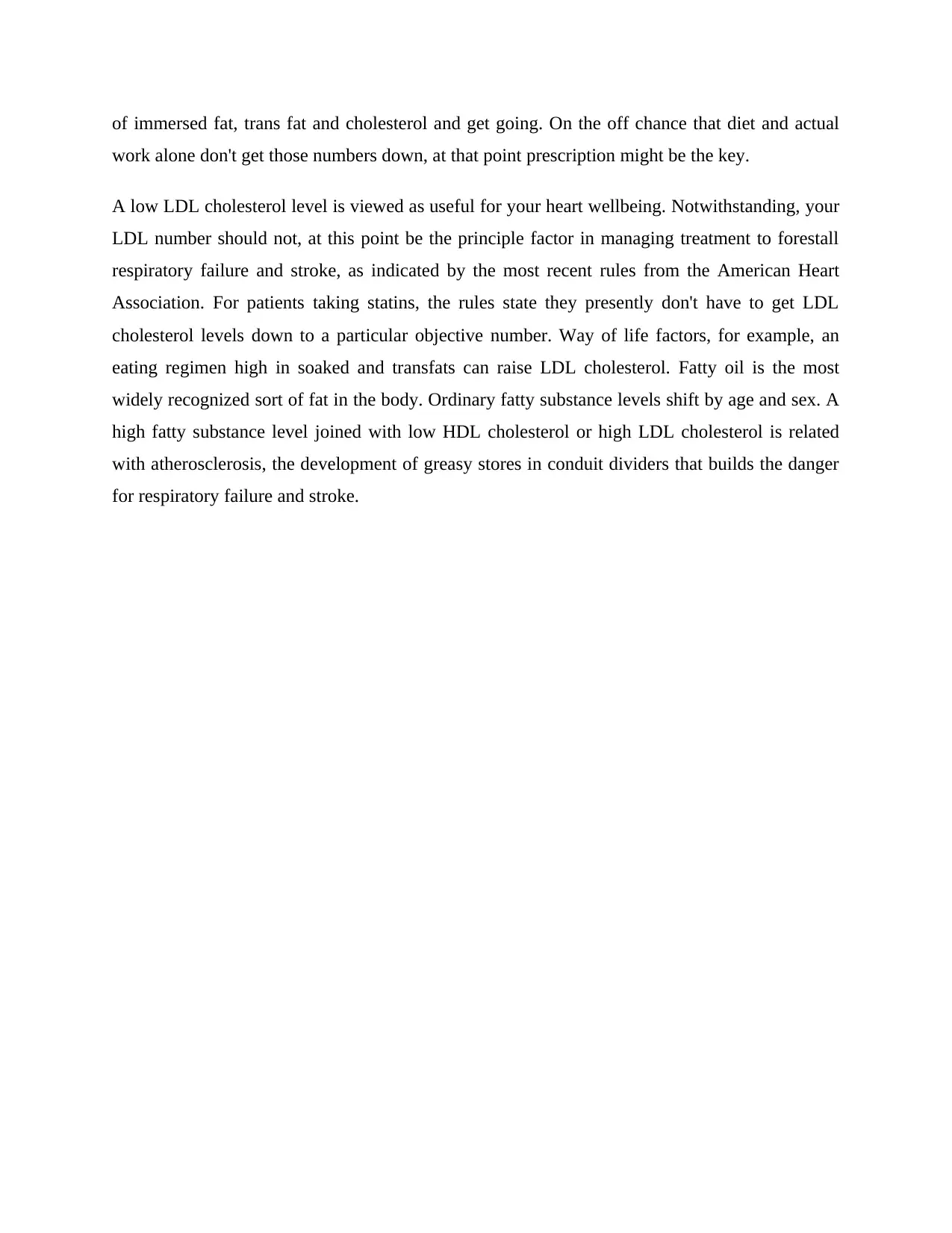
of immersed fat, trans fat and cholesterol and get going. On the off chance that diet and actual
work alone don't get those numbers down, at that point prescription might be the key.
A low LDL cholesterol level is viewed as useful for your heart wellbeing. Notwithstanding, your
LDL number should not, at this point be the principle factor in managing treatment to forestall
respiratory failure and stroke, as indicated by the most recent rules from the American Heart
Association. For patients taking statins, the rules state they presently don't have to get LDL
cholesterol levels down to a particular objective number. Way of life factors, for example, an
eating regimen high in soaked and transfats can raise LDL cholesterol. Fatty oil is the most
widely recognized sort of fat in the body. Ordinary fatty substance levels shift by age and sex. A
high fatty substance level joined with low HDL cholesterol or high LDL cholesterol is related
with atherosclerosis, the development of greasy stores in conduit dividers that builds the danger
for respiratory failure and stroke.
work alone don't get those numbers down, at that point prescription might be the key.
A low LDL cholesterol level is viewed as useful for your heart wellbeing. Notwithstanding, your
LDL number should not, at this point be the principle factor in managing treatment to forestall
respiratory failure and stroke, as indicated by the most recent rules from the American Heart
Association. For patients taking statins, the rules state they presently don't have to get LDL
cholesterol levels down to a particular objective number. Way of life factors, for example, an
eating regimen high in soaked and transfats can raise LDL cholesterol. Fatty oil is the most
widely recognized sort of fat in the body. Ordinary fatty substance levels shift by age and sex. A
high fatty substance level joined with low HDL cholesterol or high LDL cholesterol is related
with atherosclerosis, the development of greasy stores in conduit dividers that builds the danger
for respiratory failure and stroke.
Secure Best Marks with AI Grader
Need help grading? Try our AI Grader for instant feedback on your assignments.
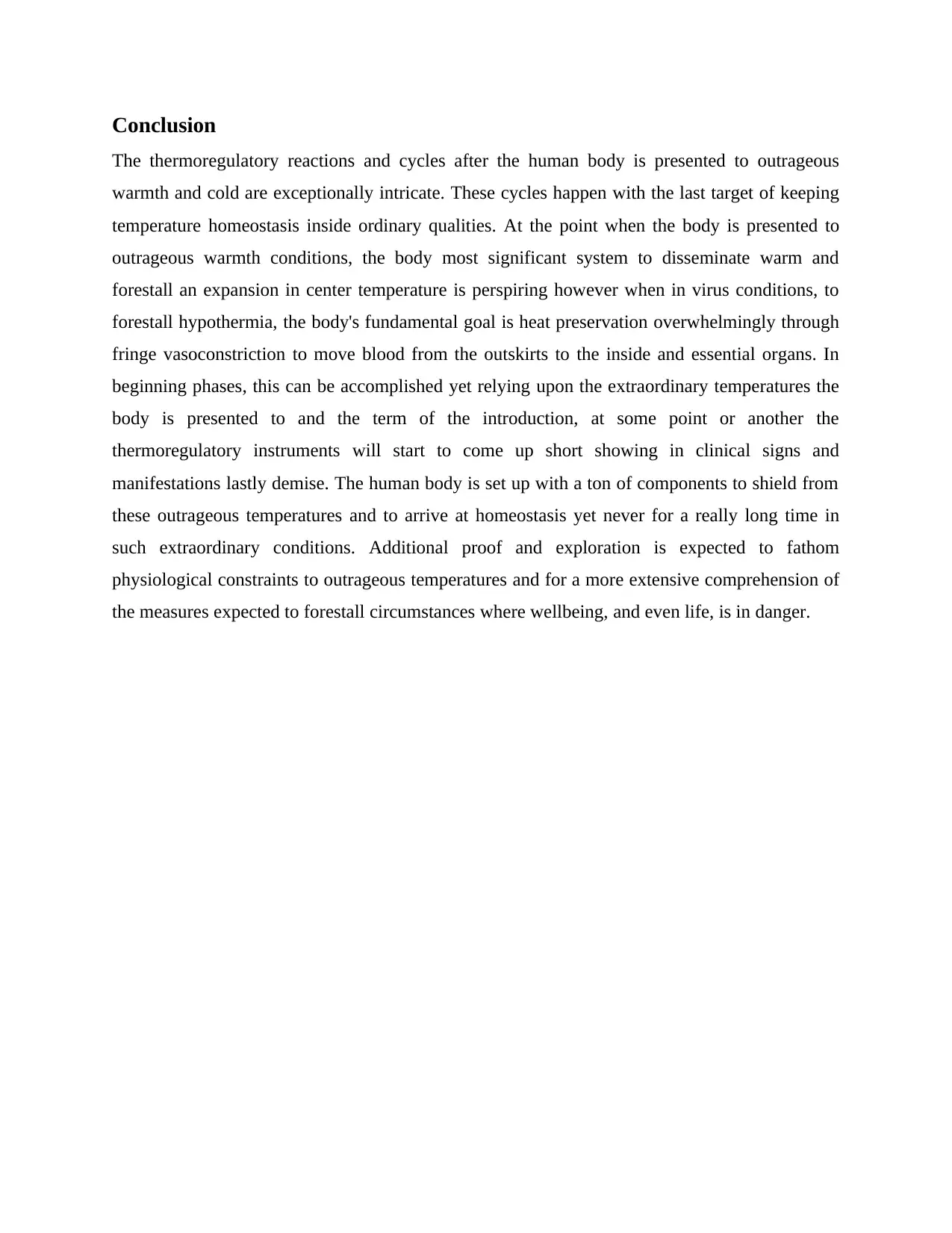
Conclusion
The thermoregulatory reactions and cycles after the human body is presented to outrageous
warmth and cold are exceptionally intricate. These cycles happen with the last target of keeping
temperature homeostasis inside ordinary qualities. At the point when the body is presented to
outrageous warmth conditions, the body most significant system to disseminate warm and
forestall an expansion in center temperature is perspiring however when in virus conditions, to
forestall hypothermia, the body's fundamental goal is heat preservation overwhelmingly through
fringe vasoconstriction to move blood from the outskirts to the inside and essential organs. In
beginning phases, this can be accomplished yet relying upon the extraordinary temperatures the
body is presented to and the term of the introduction, at some point or another the
thermoregulatory instruments will start to come up short showing in clinical signs and
manifestations lastly demise. The human body is set up with a ton of components to shield from
these outrageous temperatures and to arrive at homeostasis yet never for a really long time in
such extraordinary conditions. Additional proof and exploration is expected to fathom
physiological constraints to outrageous temperatures and for a more extensive comprehension of
the measures expected to forestall circumstances where wellbeing, and even life, is in danger.
The thermoregulatory reactions and cycles after the human body is presented to outrageous
warmth and cold are exceptionally intricate. These cycles happen with the last target of keeping
temperature homeostasis inside ordinary qualities. At the point when the body is presented to
outrageous warmth conditions, the body most significant system to disseminate warm and
forestall an expansion in center temperature is perspiring however when in virus conditions, to
forestall hypothermia, the body's fundamental goal is heat preservation overwhelmingly through
fringe vasoconstriction to move blood from the outskirts to the inside and essential organs. In
beginning phases, this can be accomplished yet relying upon the extraordinary temperatures the
body is presented to and the term of the introduction, at some point or another the
thermoregulatory instruments will start to come up short showing in clinical signs and
manifestations lastly demise. The human body is set up with a ton of components to shield from
these outrageous temperatures and to arrive at homeostasis yet never for a really long time in
such extraordinary conditions. Additional proof and exploration is expected to fathom
physiological constraints to outrageous temperatures and for a more extensive comprehension of
the measures expected to forestall circumstances where wellbeing, and even life, is in danger.
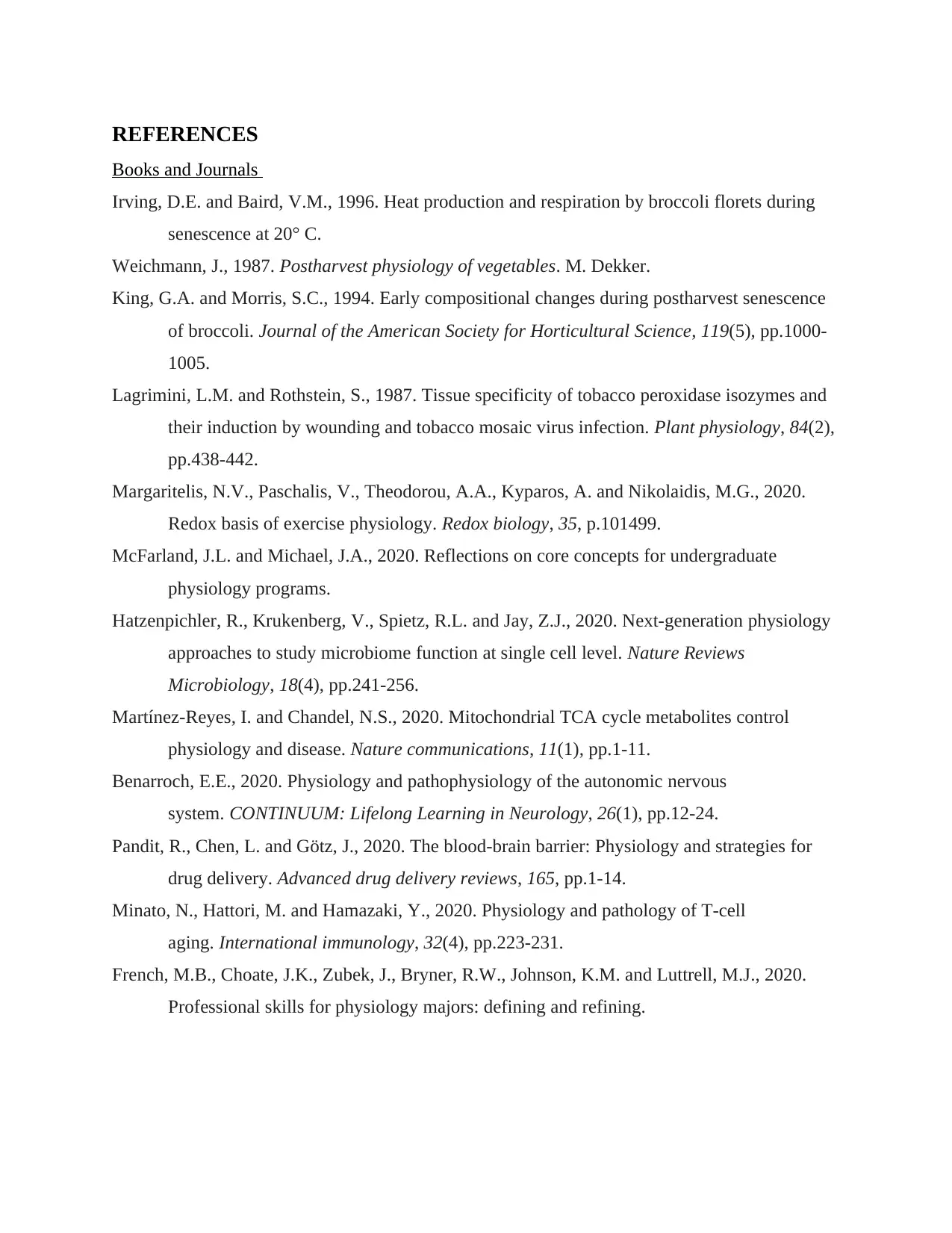
REFERENCES
Books and Journals
Irving, D.E. and Baird, V.M., 1996. Heat production and respiration by broccoli florets during
senescence at 20° C.
Weichmann, J., 1987. Postharvest physiology of vegetables. M. Dekker.
King, G.A. and Morris, S.C., 1994. Early compositional changes during postharvest senescence
of broccoli. Journal of the American Society for Horticultural Science, 119(5), pp.1000-
1005.
Lagrimini, L.M. and Rothstein, S., 1987. Tissue specificity of tobacco peroxidase isozymes and
their induction by wounding and tobacco mosaic virus infection. Plant physiology, 84(2),
pp.438-442.
Margaritelis, N.V., Paschalis, V., Theodorou, A.A., Kyparos, A. and Nikolaidis, M.G., 2020.
Redox basis of exercise physiology. Redox biology, 35, p.101499.
McFarland, J.L. and Michael, J.A., 2020. Reflections on core concepts for undergraduate
physiology programs.
Hatzenpichler, R., Krukenberg, V., Spietz, R.L. and Jay, Z.J., 2020. Next-generation physiology
approaches to study microbiome function at single cell level. Nature Reviews
Microbiology, 18(4), pp.241-256.
Martínez-Reyes, I. and Chandel, N.S., 2020. Mitochondrial TCA cycle metabolites control
physiology and disease. Nature communications, 11(1), pp.1-11.
Benarroch, E.E., 2020. Physiology and pathophysiology of the autonomic nervous
system. CONTINUUM: Lifelong Learning in Neurology, 26(1), pp.12-24.
Pandit, R., Chen, L. and Götz, J., 2020. The blood-brain barrier: Physiology and strategies for
drug delivery. Advanced drug delivery reviews, 165, pp.1-14.
Minato, N., Hattori, M. and Hamazaki, Y., 2020. Physiology and pathology of T-cell
aging. International immunology, 32(4), pp.223-231.
French, M.B., Choate, J.K., Zubek, J., Bryner, R.W., Johnson, K.M. and Luttrell, M.J., 2020.
Professional skills for physiology majors: defining and refining.
Books and Journals
Irving, D.E. and Baird, V.M., 1996. Heat production and respiration by broccoli florets during
senescence at 20° C.
Weichmann, J., 1987. Postharvest physiology of vegetables. M. Dekker.
King, G.A. and Morris, S.C., 1994. Early compositional changes during postharvest senescence
of broccoli. Journal of the American Society for Horticultural Science, 119(5), pp.1000-
1005.
Lagrimini, L.M. and Rothstein, S., 1987. Tissue specificity of tobacco peroxidase isozymes and
their induction by wounding and tobacco mosaic virus infection. Plant physiology, 84(2),
pp.438-442.
Margaritelis, N.V., Paschalis, V., Theodorou, A.A., Kyparos, A. and Nikolaidis, M.G., 2020.
Redox basis of exercise physiology. Redox biology, 35, p.101499.
McFarland, J.L. and Michael, J.A., 2020. Reflections on core concepts for undergraduate
physiology programs.
Hatzenpichler, R., Krukenberg, V., Spietz, R.L. and Jay, Z.J., 2020. Next-generation physiology
approaches to study microbiome function at single cell level. Nature Reviews
Microbiology, 18(4), pp.241-256.
Martínez-Reyes, I. and Chandel, N.S., 2020. Mitochondrial TCA cycle metabolites control
physiology and disease. Nature communications, 11(1), pp.1-11.
Benarroch, E.E., 2020. Physiology and pathophysiology of the autonomic nervous
system. CONTINUUM: Lifelong Learning in Neurology, 26(1), pp.12-24.
Pandit, R., Chen, L. and Götz, J., 2020. The blood-brain barrier: Physiology and strategies for
drug delivery. Advanced drug delivery reviews, 165, pp.1-14.
Minato, N., Hattori, M. and Hamazaki, Y., 2020. Physiology and pathology of T-cell
aging. International immunology, 32(4), pp.223-231.
French, M.B., Choate, J.K., Zubek, J., Bryner, R.W., Johnson, K.M. and Luttrell, M.J., 2020.
Professional skills for physiology majors: defining and refining.
1 out of 18
Related Documents
Your All-in-One AI-Powered Toolkit for Academic Success.
+13062052269
info@desklib.com
Available 24*7 on WhatsApp / Email
![[object Object]](/_next/static/media/star-bottom.7253800d.svg)
Unlock your academic potential
© 2024 | Zucol Services PVT LTD | All rights reserved.





